|
Higgins Industries Time Line in
World War Two
Higgins PT-305 Video
Higgins
Industries in World War Two
Includes Higgins
Aircraft, Higgins Engine Company, and Higgins Plastic Corporation
New Orleans, LA
1930-1945
An
American Auto Industry in World War Two Special Edition
This page updated 6-15-2024.
Higgins Industries was not part of the
American Automobile Industry. It was far from it, as the company
was in New Orleans, LA, and the builder of shallow draft wooden boats. The owner of the
company, Andrew Jackson Higgins, was a flamboyant and self assured
entrepreneur, who was always willing to speak his mind. One of the
subjects he quite frequently addressed was the need for proper landing
craft for American marines and soldiers with equipment to use for landing on hostile
beaches. He had a long series of disagreements with the Navy
Bureau of Ships on the proper design of these type landing craft so that
they could land right up on the beach. In the end, it was Andrew
Higgins' final design of the famous "Higgins" landing craft, the Landing
Craft, Vehicle, Personnel (LVCP), and the Landing Craft, Medium (LCM)
that were accepted. The LCVP became the most
produced landing craft of World War Two. But the LCVP was the last
of several design iterations that finally progressed to become the Higgins
boat. The original version still had the soldiers jumping over the
gunwales to get out of the boat, just as they had been doing since men
started landing on hostile beaches.
Higgins Industries is also known for
manufacturing Motor Torpedo Boats, more commonly known as PT
boats. While Higgins Industries is most well-known for its design
and production of the Higgins boat landing craft and PT boats, the
Higgins' design of the Landing Craft, Mechanized (LCM) in December 1941
was also an important contribution to the war effort that has been
largely overlooked. The company also built several other types of
boats and ships that have also gone unrecognized. Andrew Higgins
formed several other companies to make non-boat products for wartime use. Late in
the war, as part of a secret project, Higgins Industries produced carbon
parts used in the Manhattan Project at Oak Ridge, TN, to separate U-235
from U-238. He also formed several other companies to build
aircraft and aircraft engines. Neither of these companies
ended up building any appreciable products for the war effort.
World War Two made household names out of Higgins Industries and
Andrew Higgins. Before the war, his company was a
small boat manufacturer. His design of the Eureka landing boat and
his persistence in getting it accepted made Higgins Industries the
largest manufacturer of boats built in the world.
When the war ended, the demand for thousands of landing craft ceased.
Higgins Industries was taken into receivership, largely due to labor
issues in November 1945. While the company was reorganized as
Higgins Incorporated, the bloom was off. It would never regain the former
glory and importance it had during World War Two.
There was a direct link between the American
Auto Industry in Detroit, MI and Higgins Industries in New Orleans, LA.
Automakers in Detroit built most of the engines that went into the boats
built by Higgins. All of the engines used in
the Higgins built PT boats had three Packard 4M2500 marine engines.
Most of the landing craft Higgins built had Detroit Diesel Division of
General Motors 6-71 diesel engines modified by Gray Marine Motor Company
in Detroit, MI. It was the preferred engine for U.S. landing craft
in World War Two. When Gray/Detroit Diesel engines were not
available, gasoline powered engines built by the U.S. Auto industry were
used.
Author's Note:
Some of the information below are from
"Andrew Jackson Higgins and the Boats that Won World War Two" by Jerry
E. Straham, published in 1994 by the Louisiana University State Press. When
I reference the book below, I will note it as "Higgins Biography."
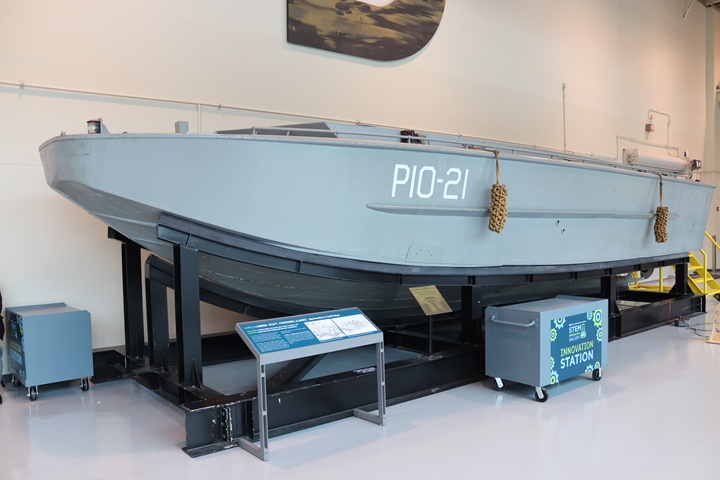
This 1944 Landing Craft, Personnel, Large (LCP(L))
was the first type of landing craft that Andrew Higgins designed.
This particular boat was built by Higgins Industries in New Orleans in
October 1944, and is currently on display
at the National WWII Museum in New Orleans.
It has returned home for museum visitors to see. It is the
only one on display left in the world. Author's photo.
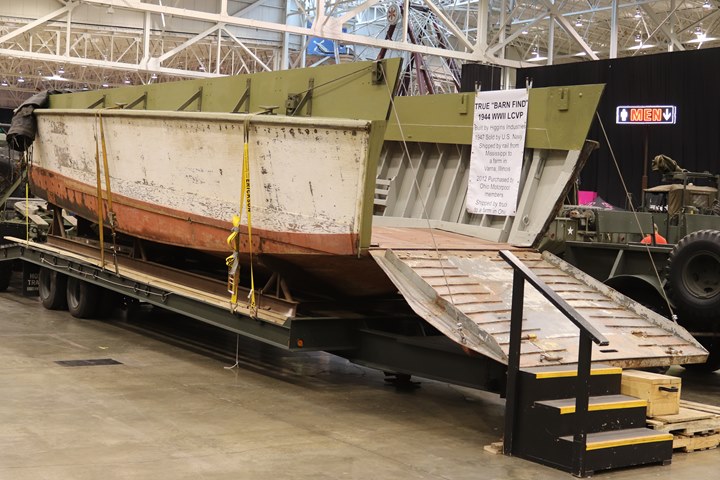
This is Andrew Higgins' most famous landing
craft design, the LCVP or Landing Craft, Vehicle, Personnel. It
was better known as the Higgins boat. Only twelve
original LCVPs still remain of the 23,358 built by seven
different boat manufacturers. Of the twelve remaining original Higgins boats, this is only one of two known to have been built by Higgins
Industries. It is owned by three members of the Ohio Motor Pool.
Author's photo.
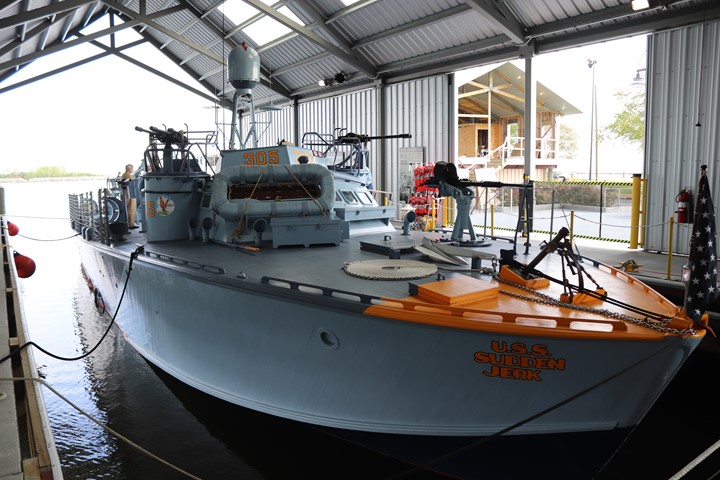
Higgins Industries is also known for
building PT boats during World War Two. This is one of only four remaining Higgins-built
PT boats left in the world. It is fully operational and is owned
by the National WWII Museum in New Orleans. It gives rides for
those that want to experience a little bit of what it was like to serve
on a PT boat in World War Two. This photo and others on this page
are from my ride on it in March 2018.
Author's photo.
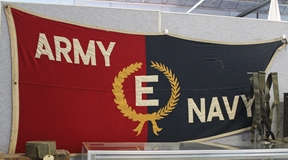
Higgins Industries won the Army-Navy Award
five times.
The award included the Industrial Canal, the City Park, and the Bayou
St. John Plants.
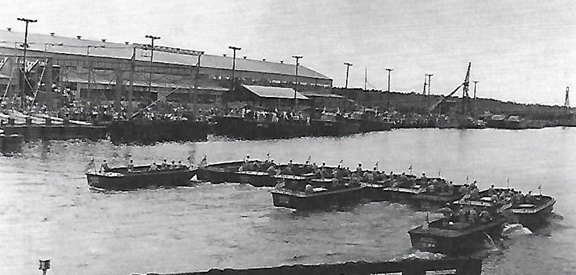
The celebration of the first "E" Award on
September 13, 1942 at the Industrial Canal Plant. An "E" is formed
by students from the Higgins Boat Operators School. The students
are all piloting LCP(L) landing craft.
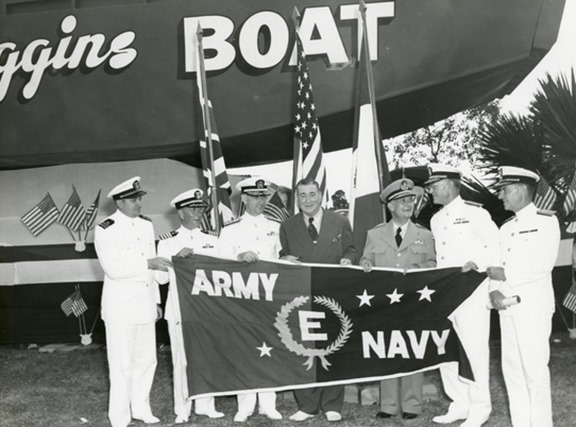
Four stars on the Higgins Army-Navy "E"
Award Flag. A smiling Andrew Jackson Higgins stands among Navy
officers as his company is given its final "E" award on July 23,
1944. The flag was presented for the initial award. Then a
star was added each time the award was renewed. Not many companies
received so many stars.
Higgins Industries World War Two Production Statistics:
There is some confusion and misinformation regarding the
number of landing craft built by Higgins Industries during World War
Two. Please bear with me as we work through the analysis below.
Boats:
Higgins Industries is credited with building 20,094 total "boats" in
World War Two. This is based on the photo below.
Author's Note: Higgins Industries
did not build LSTs or Liberty Ships during World War Two.
Several inaccurate historical websites claim Higgins built these type
ships. There were plans for Higgins to build 100 Liberty Ships,
but this project was cancelled. The company built several
varieties of ships and boats as shown below.
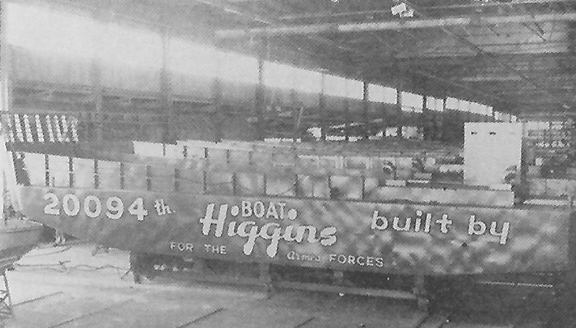
The question arises. What does the "20,094th boat built by Higgins"
actually include? Some sources imply that these were Higgins-built
36-foot wooden landing craft (LCP(L), LCV, LCVP).
See Table 1 below. Production numbers
for LCP(L), LCP(R), LCV, and LCVP for most manufacturers are incomplete
or non-existent. Table 1 shows that Higgins Industries built
around 14,800 36-foot landing craft during World War Two. This was
49% of the total built. For more information Chris-Craft
production numbers, visit my Chris-Craft Page.
|
Table 1
36-foot Landing Craft built during World War Two |
|
Column A |
Column B |
Column C |
Column D |
Column E |
|
Type |
Higgins Production |
Known Production by Other
Manufacturers |
Columns B+C |
Total Production by all
Manufacturers by Year |
|
LCP(L) |
~1,100 |
Chris-Craft=1,200
Matthews Company=see subtotal below
Owens Yacht Company=see subtotal below
Richardson Boat=see subtotal below |
2,300 |
1941- 564
1942- 307
1943- 282
1944 - 547
1945 - 493
Total - 2,193 |
|
LCP(R) |
0 |
Chris-Craft=1,773
Matthews Company=see subtotal below
Richardson Boat=see subtotal below |
1,773 |
1942 - 1,563
1943 - 24
1944 -705
1945 - 339
Total - 2,631 |
|
LCV |
~1,200 |
Chris-Craft=1,425
Owens Yacht Company=see subtotal below |
2,645 |
1941- 110
1942 - 1,891
1943- 365
Total - 2,366 |
|
LCVP |
12,500 |
Chamberlain=?
Chris-Craft=8,602
Dodge Boat and Plane=74
Matthews Company=496
Owens Yacht Company=see subtotal below
Richardson Boat=604 |
21,176 |
1942- 215
1943- 8,027
1944 - 9,290
1945 - 5,826
Total - 23,358 |
|
Owens Yacht Co |
|
Owens Yacht Co=2,150 total LCP(L), LCV, LCVP |
2,150 |
|
| Richardson Boat
Company |
|
Richardson Boat
Company=~1,000 total LCP(L), LCV, 604 LCVP |
1,000 |
This number may well
include the LCMs that Richardson built. The Tonawanda
Heritage Center was not able be discern the difference between
Higgins boats and LCMs in photos. |
| Matthews Company
|
|
Matthews Company =~
2,555 total LCP(L), LCV, 496 LCVP |
2,555 |
At the end of the
war Matthews was producing two landing craft a day or 730 boats
per year. Over a three and a half year period this would be
2,555 landing craft of all types. This is the best
estimate for this company at this time. |
| Totals for 36-Foot
Wooden Landing Craft |
14,800 |
15,224 |
33,599 |
30,548 |
Column A
Type |
Column B
Higgins Production |
Column C
Known Production by Other Manufacturers |
Column D
Columns B+C |
Column E
Total Production by all Manufacturers by Year |
Calculation of the number
of Higgins-built LCVPs in World War Two - The figure 12,500 is the
number that is found on several sources for the total number of LCVPs
that Higgins Industries built during World War Two. Is this an
accurate number considering the lack of supporting data? I have
found it is by putting several pieces of data together and using
information from Table 1A below.
Method One:
-
July 1943 production of
LCVPs is 600 from "Higgins Biography." Total production of
LCVPs for July 1943 was 1,073 from Table 1A. Higgins was
building ~60% of the LCVPs. This is fairly correct based on the
fact that Chris-Craft was building around 40%. The number of LCVPs
built by the other four manufacturers were small and can be
ignored in this analysis.
-
July 1943 production of
1,072 LCVPs was a one-time event. Looking at the available
data of LCVPs built between August 1943 and May 1944 shows that an
average of 850 were being built per month. 8,499/10= 849.9
rounds up to 850. Assume Higgins continued to build 60% of
LCVPs. This is 510 units per month. Without doing the
calculations, I had estimated Higgins Industries was building around
500 a month.
-
October 1944 - 7,000th
LCVP built from "Higgins Biography."
-
There were still 10.5
months of production left until the end of World War Two in the
middle of September 1945.
-
Assume the same rate of
production of LCVPs of 850 total units until the end of the war.
-
510 Higgins LCVPs built
per month X 10.5 months = 5,355 LCVPs built in that time period.
-
7,000 + 5,355 = 12,355.
This is very close to the 12,500 given by other sources.
Higgins Industries built 53% of all of the LCVPs built during World
War Two.
Method Two:
-
Assume Higgins
Industries built 60% of the LCVPs during World War Two as noted in
Method One.
-
From Table 1A as of May
1944 12,354 LCVPs had been built. Another 11,004 remained to
be built. 23,358 total LCVPs built - 12, 354 built through May
1944 = 11,004 LCVPs left to be built.
-
11,004 X .6 (60%) =
6,602
-
7,000 + 6,602 = 13,602.
This is higher than the 12,500 given by other sources but still
within reason.
This has been a "sanity
check" to determine if the total 12,500 Higgins-built LCVPs given by
other sources has any logical basis. Yes, it does. It also
reconciles with the LCVP information in Table 1 that estimates 2,182
LCVPs (23,358-21,176 = 2,182) were built by Chamberlain, Matthews and
Richardson. Based on their total production, this reconciles rather
well.
|
Table 1A
Higgins Designed Landing Craft Monthly Production January
1942-May 1944 - All Manufacturers |
|
Month-Year |
LCM(3) and LCM(6) |
LCP(L) and LCV |
LCVP |
Totals for LCP(L) and LCV and LCVP |
Comments |
|
Jan-1942 |
18 |
116 |
0 |
|
|
|
Feb-1942 |
10 |
0 |
0 |
|
|
|
Mar-1942 |
0 |
117 |
0 |
|
|
|
Apr-1942 |
1 |
174 |
0 |
|
|
|
May-1942 |
27 |
248 |
0 |
|
|
|
Jun-1942 |
35 |
344 |
0 |
|
|
|
Jul-1942 |
118 |
480 |
0 |
|
|
|
Aug-1942 |
307 |
600 |
0 |
|
|
|
Sep-1942 |
131 |
477 |
0 |
|
|
|
Oct-1942 |
203 |
394 |
0 |
|
|
|
Nov-1942 |
244 |
466 |
75 |
|
|
|
Dec-1942 |
168 |
345 |
140 |
|
|
|
Totals 1942 |
1,262 |
3,761 |
215 |
3,976 |
|
| |
|
|
|
|
|
|
Jan-1943 |
114 |
37 |
205 |
|
|
|
Feb-1943 |
156 |
44 |
319 |
|
|
|
Mar-1943 |
406 |
18 |
655 |
|
|
|
Apr-1943 |
143 |
57 |
405 |
|
|
|
May-1943 |
236 |
0 |
416 |
|
|
|
Jun-1943 |
146 |
0 |
567 |
|
|
|
Jul-1943 |
244 |
0 |
1,073 |
|
|
|
Aug-1943 |
401 |
0 |
812 |
|
|
|
Sep-1943 |
502 |
0 |
943 |
|
|
|
Oct-1943 |
585 |
50 |
836 |
|
|
|
Nov-1943 |
563 |
50 |
921 |
|
|
|
Dec-1943 |
523 |
50 |
875 |
|
|
|
Totals 1943 |
4,019 |
306 |
8,027 |
8,333 |
|
| |
|
|
|
|
|
|
Jan-1944 |
578 |
50 |
833 |
|
|
|
Feb-1944 |
641 |
50 |
932 |
|
|
|
Mar-1944 |
594 |
50 |
811 |
|
|
|
Apr-1944 |
470 |
50 |
744 |
|
|
|
May-1944 |
487 |
50 |
792 |
|
|
|
Totals 1944 |
2,770 |
250 |
4,112 |
4,362 |
|
|
Grand Total |
8,051 |
4,317 |
12,354 |
16,671 |
Totals including 564 LCP(L)
built in 1941 and the 2,633 LCVs built from 1941-1943 totals
19,898 "Higgins" landing craft of all types. |
Link to:
10,000 "Higgins Boat" Ceremony, July 23, 1944
The page in the link above from The National World War Two Museum
shows an LCV as the 10,000th Higgins boat landing craft built on July
23, 1944. From the information in Table 1, there were no LCVs
built in 1944. Production stopped in 1943. The landing craft
in the photo can be identified as an LCV by the fact that the coxswain's
steering position was located on the stern deck above the cargo deck.
This was not the case for the LCVP, where the steering position was down
next to the engine.
Table 2
Various Boats built by Higgins Industries for the U.S.
Army during World War Two |
|
Type |
Designation |
Number built |
Dates built |
Comments |
| 170
and 180-foot Steel FS Coastal Freighters |
FS-135 to FS-234 |
100 |
9-43
to 3-45 |
575
Tons |
| J
Boats |
J |
335 |
4-41
to 6-44 |
These
came in three lengths: 27, 36 and 37 feet. Uses:
Shallow-Draft, Patrol, Utility and Fireboat |
|
36-foot CL Landing Boats |
CL-1
to Cl-130 |
130 |
1-41
to 4-43 |
|
|
Barges |
BSP
395, BK 101-400, TKL-9, BK |
316 |
5-42
to 5-45 |
These
came in four lengths: 53, 63, 50 and 80 feet. Uses:
Balloon, Tank, and Knock-Down |
|
Small Tugs |
ST 204-213 |
10 |
3-43 to 6-43 |
|
|
Various small boats |
Various |
18 |
1941 to 1944 |
33 to 53 feet long |
|
Total |
|
909 |
|
|
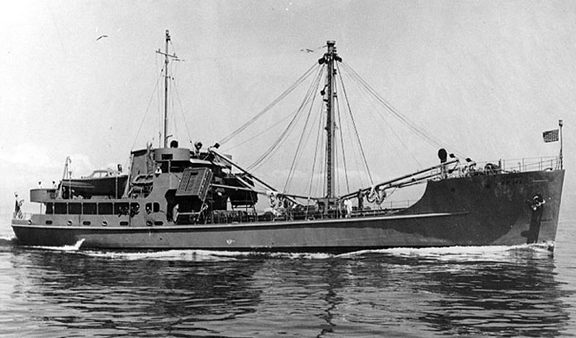
Higgins Industries built 100 170/180-foot coastal freighters like
this one for the U.S. Army. In the southwest Pacific the Army
had its own navy.
|
Table 3
Higgins World War Two PT Boat Production by Month January
1941 - October 1945
Below is a tabulation
of the 216 PT boats built by Higgins Industries during World
War Two. |
|
Month-Year |
Number built |
PT- Number |
Length |
Comments |
|
Jan-1941 |
1 |
6(1) |
81-foot Prototype |
Built at the St. Charles Avenue Plant. |
|
Feb-1941 |
1 |
6(2) |
81-foot Prototype |
Built at the St. Charles Avenue Plant. |
|
Mar-1941 |
1 |
5 |
81-foot Prototype |
Built at the St. Charles Avenue Plant. |
|
Sep-1941 |
1 |
70 |
72-foot Prototype |
Built at the St. Charles Avenue Plant. |
|
Unknown |
1 |
7
(See Note Below) |
81-foot Prototype |
Built at the St. Charles Avenue Plant. |
|
Unknown |
1 |
8
(See Note Below) |
81-foot Prototype |
Built at the St. Charles Avenue Plant. |
|
Total 1941 |
6 |
|
|
|
| |
|
|
|
|
|
Jul-1942 |
2 |
71, 72 |
78-foot Production |
Production begins at the City Park Plant |
|
Aug-1942 |
4 |
73,
74,75,76 |
78-foot Production |
|
|
Sep-1942 |
4 |
77, 78, 79, 80 |
78-foot Production |
|
|
Dec-1942 |
13 |
82, 83, 84, 85, 86, 87, 88, 89, 90, 91, 92, 93, 94 |
78-foot Production |
PT-88, 90-93 served with Royal Navy in the Mediterranean at
MTB 419-423. |
|
Total 1942 |
23 |
|
|
|
| |
|
|
|
|
|
Jan-1943 |
11 |
81, 197, 198, 199, 200, 201, 202, 203, 204, 205, 206 |
78-foot Production |
|
|
Feb-1943 |
10 |
207, 208, 209, 210, 211, 212, 213, 214, 215, 216 |
78-foot Production |
|
|
Mar-1943 |
16 |
217, 218, 219, 220, 221, 222, 223, 224, 225, 226, 227, 228,
229, 230, 231, 232 |
78-foot Production |
|
|
Apr-1943 |
8 |
233, 234, 235, 236, 237, 238, 239, 240 |
78-foot Production |
|
|
May-1943 |
11 |
241, 242, 243, 244, 245, 246, 247, 248, 249, 250, 251 |
78-foot Production |
|
|
Jun-1943 |
6 |
252, 253, 254, 279, 280, 564* |
78-foot Production |
*PT-564 70-foot Hellcat Prototype |
|
Jul-1943 |
10 |
277, 278, 281, 282, 283, 284, 285, 286, 287, 288 |
78-foot Production |
|
|
Aug-1943 |
9 |
265, 266, 267, 268, 269, 270, 271, 289, 290 |
78-foot Production |
|
|
Sep-1943 |
9 |
272, 273, 274, 275, 276, 291, 292, 293, 294 |
78-foot Production |
|
|
Oct-1943 |
6 |
295, 296, 297, 298, 299, 300 |
78-foot Production |
|
|
Nov-1943 |
4 |
301, 302, 303, 304 |
78-foot Production |
|
|
Dec-1943 |
3 |
305, 306, 307 |
78-foot Production |
|
|
Total 1943 |
103 |
|
|
|
| |
|
|
|
|
|
Jan-1944 |
6 |
308, 309, 310, 311, 312, 313 |
78-foot Production |
|
|
Feb-1944 |
5 |
450, 451, 452, 454, 455, |
78-foot Production |
|
|
Mar-1944 |
8 |
453, 456, 457, 458, 459, 460, 461, 462 |
78-foot Production |
|
|
Apr-1944 |
8 |
463, 464, 465, 466, 467, 468, 469, 470 |
78-foot Production |
|
|
May-1944 |
3 |
471, 472, 473 |
78-foot Production |
|
|
Jun-1944 |
4 |
474, 475, 476, 478, |
78-foot Production |
|
|
Jul-1944- |
4 |
477, 479, 480, 481, |
78-foot Production |
|
|
Aug-1944 |
4 |
482, 483, 484, 485 |
78-foot Production |
|
|
Dec-1944 |
2 |
625, 626 |
78-foot Production |
|
|
Total 1944 |
44 |
|
|
|
| |
|
|
78-foot Production |
|
|
Jan-1945 |
3 |
627, 628, 629 |
78-foot Production |
|
|
Feb-1945 |
2 |
630, 631 |
78-foot Production |
|
|
Mar-1945 |
5 |
632, 633, 634, 635, 636 |
78-foot Production |
|
|
Apr-1945 |
6 |
637, 638, 639, 640, 641, 642 |
78-foot Production |
|
|
May-1945 |
7 |
643, 644, 645, 646, 647, 648,
649 |
78-foot Production |
|
|
Jun-1945 |
4 |
650, 651, 652, 653 |
78-foot Production |
|
|
Jul-1945 |
5 |
654, 655, 656, 657, 658 |
78-foot Production |
|
|
Aug-1945 |
2 |
659, 660 |
78-foot Production |
|
|
Sep-1945 |
2 |
791, 792 |
78-foot Production |
|
|
Oct-1945 |
4 |
793, 794, 795, 796 |
78-foot Production |
|
|
Total 1945 |
40 |
|
|
|
|
Grand Total |
216 |
|
|
|
Additional Author's
Note: Most historical PT sources state 199 or 209 Higgins
PT boats built. I do not know how the 199 was derived.
I have never seen the data as to how 199 was derived. For the
209, the sources use the same information provided in Table 3 minus
PT-7 and PT-8, which are only documented on this website.
Therefore, the total number should be 214, not 209. The
original author who did the work made a mathematical error.
Then all the persons who followed who used the table above, copied
the information without checking the addition for correctness,
and continued to propagate the error over and over again.
|
Table 3A
Higgins World War Two PT, MTB, and MGB Production for
foreign countries during World War Two
|
|
Type |
Month-Year |
Number built |
Designation |
Length |
Comments |
| Dutch
Anti-Submarine |
1941 |
6 |
OJR 1-6 |
70 foot |
These six
boats arrived in the Dutch East Indies between December 16,
1941, and March 2, 1942. All were either scuttled or
lost in a gasoline explosion during the Japanese invasion.
Either OJR-1 or OJR-4 was raised by the Japanese and
commissioned August 4, 1943 as Auxiliary Submarine Chaser
101. It was sunk by American forces on April 8, 1945.
So for two years a Higgins built boat was fighting for the
Japanese. |
| Dutch
Anti-Submarine |
1942 |
2 |
H 7-8 |
70 foot |
These two
craft arrived in the Dutch West Indies on August 26,1942 and
served on anti-submarine patrol. Both boats were
stricken in early 1946.
Photos of these two boats are
shown below. |
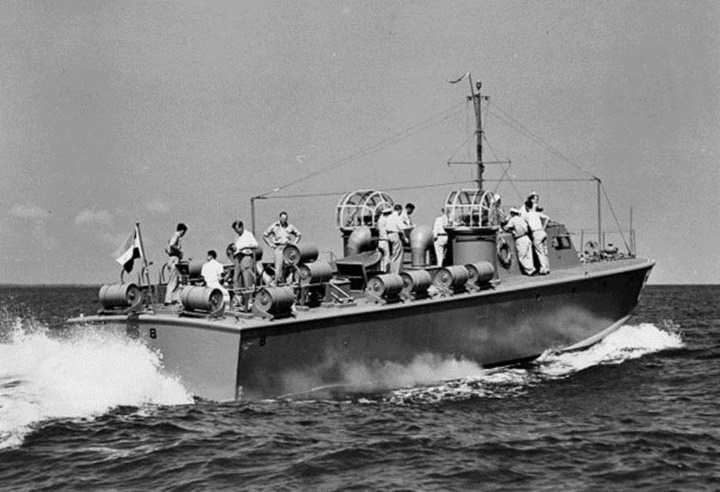
Note the number 8 and the Dutch flag on
the stern of the boat. H-8 was a 70-foot anti-submarine boat
armed with 16 depth charges and four .50 caliber machine guns in the
two turrets. It was used by Dutch forces in the Caribbean
after August 1942. Photo added 5-22-2019.
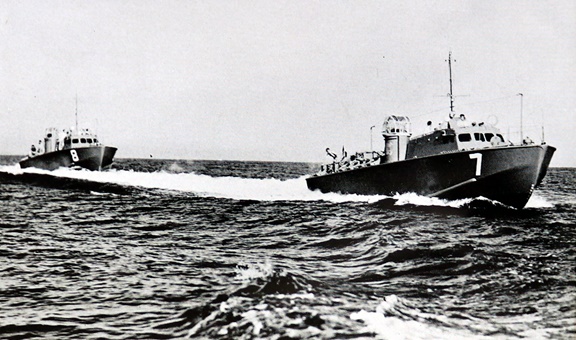
H-7 and H-8 running together.
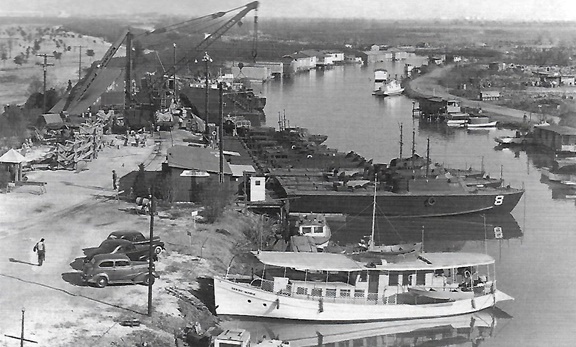
H-8 is clearly visible at Bayou St.
John in this photo. H-7 looks to be moored behind H-8.
Both boats were delivered to the Dutch in the Caribbean in August
1942. This photo was taken at Bayou St. John earlier in the
year.
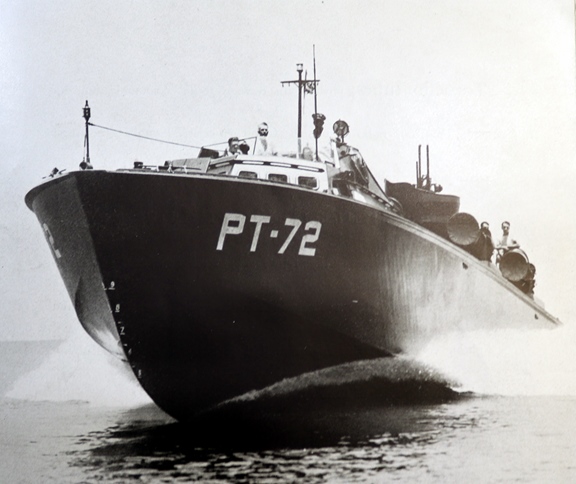
PT-72 was laid down on March 2, 1942,
launched on July 6, 1942, and completed on July 23, 1942. PT-72
served throughout World War Two with combat duty in the Aleutians.
Then from May 1944 to October 1944 it was part of MTBRon 2(2) which was
assigned to the OSS for special operations in the English Channel.
Table 4
Pre-1942 landing boat orders documented in the "Higgins
Biography" not comprehended in the above tables |
| Date |
Number |
Type |
Customer |
| Oct 1940 |
138 |
Eurekas |
British |
| Nov 1940 |
335 |
Eurekas
with a flatter bottom design |
US Navy |
|
Total |
473 |
|
|
|
Table 5
Total of all Types of Boats built by Higgins Industries in World
War Two |
|
Type |
Number built |
| 36-Foot Landing
Craft - Table 1 |
14,800 |
| Various Types of
Boats- Table 2 |
909 |
| PT Boats- Table
3 |
216 |
| Landing Craft,
Mechanized - |
1,400 |
| LCS(S) Total
built, may not all be Higgins |
558 |
| RAF Air-Sea
Rescue Boats. Higgins built "hundreds." Estimated
at 300 |
300 |
| B-17 life boats -
Estimated at 100 |
100 |
| Pre-1942 Landing
Boat Orders |
473 |
|
Totals |
18,756 |
Summary: My
calculations and estimates for the total number of boats built by
Higgins Industries in World War Two is 18,756. This is 1,338 short
of the 20,094 painted on the side of the boat at the beginning of this
section. In reference to the estimated 300 RAF Air-Sea Rescue
boats, the "Higgins Biography" states Higgins built "hundreds." I
have not been able to verify that with any other documentation
concerning RAF boats of this type. The "Higgins Biography" makes
several references to the production of the LCS (Landing
Craft, Support) boat. There were two types of LCS built during
World War Two. The LCS(L) (Landing Craft, Support, Large) was
built by several shipyards, and Higgins was not one of them.
However, the Landing Craft, Support, Small (LCS(S) was a small wooden
boat of similar size to the landing craft that Higgins was building.
I think the rocket boat and LCS referred to in the "Higgins Biography"
were actually one and the same LCS(S). I assumed that all of
the 558 LCS(S) types were built by Higgins.
-83w-1.jpg)
The "Higgins Biography" mentions rocket
boats twice and LCS several times. They are one and the same.
Higgins built the LCS(S) in both Houma and New Orleans,
LA. The 36-foot boat was armed with rocket launchers on each side
of the cockpit. A total of 558 of these are documented as having
been built during World War Two. These appear to have been built
off of the Eureka design, as they are the same length and have the blunt
nose of the LCP(L) designed by Higgins. The advertisement at the
bottom of the page best shows the blunt nose of the craft.
rocket-52w-1.jpg)
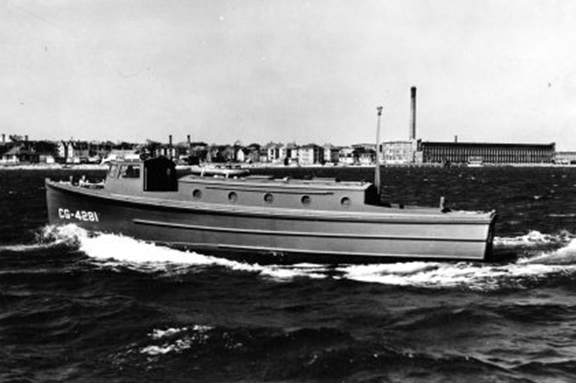
In its wartime advertisements, Higgins
Industries show photos of the Coast Guard 38-foot picket boat as being
built during the war. It is unknown how many were built by
Higgins.
Other products built by
Higgins Industries in World War Two: Higgins has been
identified as building the following products in "History in a Hurry -
The Story of Higgins of New Orleans." While these products are
listed to show the company's diversification, for all intents and
purposes, Higgins Industries built boats. 20,094 of them during
World War Two. Several of the products listed below, like the
torpedo tubes and gun turrets, were for internal use on its PT boats.
Other products, like the marine engines and aircraft, were not built in
significant numbers. Two products that were built in significant numbers were the
air-dropped life boat and carbon parts for the Manhattan Project.
Products: Torpedo tubes, power gun turrets for PT boats, sound communicating
devices, paratroop radio telephones, frequency crystals, smoke
generators, water purifiers and salt water converters, engine clutch and
reverse gear mechanisms, hypoid and helical gears, plastic bonded wood
products, life boat releasing gears, turbine type pumps, remote engine
controls, mechanical steering devices, twin-machine gun turrets, cannon
stabilizer and sighting controls, marine engines. (1) C-46,
300 A-1 lifeboats, carbon parts for the Manhattan Project.
Tucker Aviation: Higgins purchased the Tucker
Aviation of Ypsilanti, MI in March 1942, and formed Higgins-Tucker
Aviation to
build engines and gun turrets for PT boats and for landing craft.
Many of the products listed above, besides the gun turrets, may have also
come along with the purchase. Tucker Aviation had $250 million in
military contracts when it was purchased. At the end of the war,
several marine engines had been tested and were production ready.
The war was over, and the shortage of Packard engines for the PT boats
never materialized.
C-46 Commando:
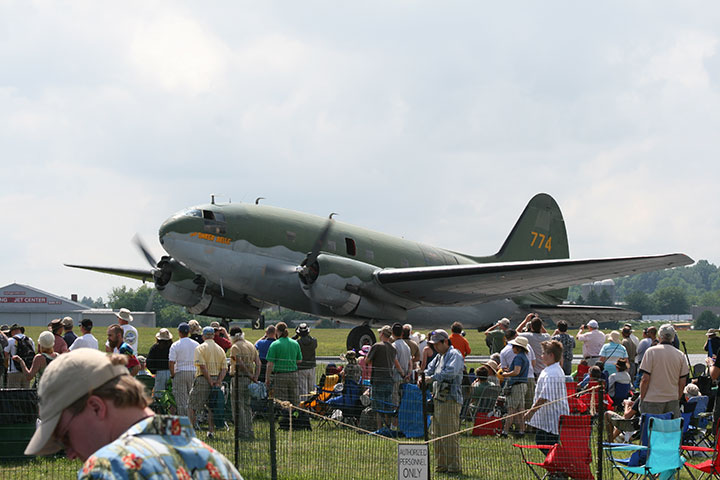
Higgins Aviation was contracted to build 500 Curtiss C-46 Commandos at the aircraft
assembly plant in Michoud. These were serial numbers 43-43339
through 43-43338. By the time Higgins was ready to build
the C-46, the faster than expected progression of the war in the Pacific
reduced the need for the aircraft. The contract with Higgins was
cancelled, with only two C-46s produced at Michoud. These were
43-43339 and 43-43340. This was the
second aircraft contract cancelled on Higgins. The first was for 1,200
Curtiss C-76 Caravan wood construction transports. Beginning in October 1943,
Higgins Aircraft started building wing
assemblies for the C-46 which were shipped to the Curtiss C-46 assembly
plants in Louisville, KY and St. Louis, MO. Author's Photo.
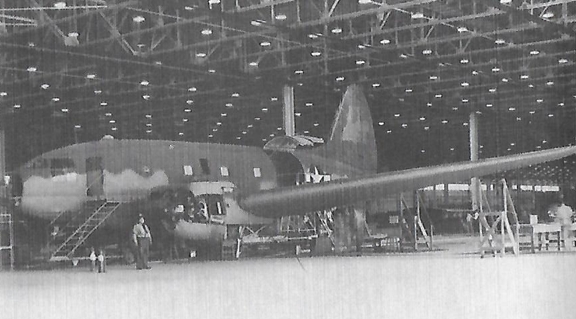
This is one of the two Higgins-built C-46s and has
final work being performed on it at the Michoud
aircraft plant.
Higgins A-1 Air Droppable Lifeboat:
Design work began in November 1943. By the spring of 1944, the A-1 was
in production. The original order was for 600 A-1s; but the order
was changed and 300 were built. Higgins Plastic Company produced the 27-foot long
3,300-pound boat out of laminated mahogany at the Michoud Plant.
It contained 20 internal waterproof compartments that would keep the
vessel afloat even if it tipped over. Included in the supplies for
the A-1 was a Gibson Girl survival radio and enough food and water to
last twelve survivors twenty days. Equipped with two air-cooled
gasoline powered engines, it had a range 1,500 miles running at eight
knots. There was also a small, simple sail that could be used if
needed. Its design allowed it to be dropped with three parachutes
from a B-17 still equipped with a ball turret. When the A-1 hit
the water, small rockets would fire and pull lifelines out from the boat. The A-1 was
replaced by the A-3 in 1947.
There was also an 18-foot version of the A-1
to be dropped by a U.S. Coast Guard PBY Catalina. It could hold no
more than eight persons.
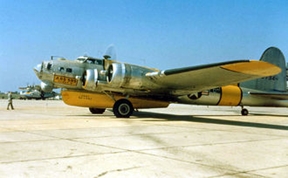
The Higgins A-1 lifeboat attached to a
SB-17G.
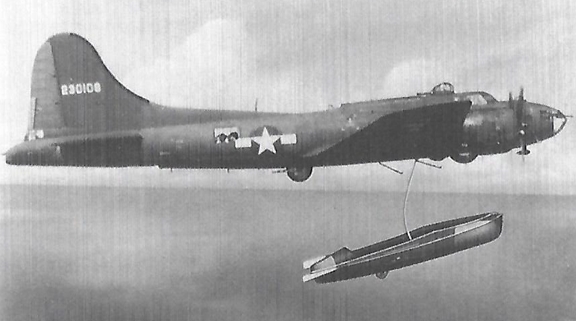
The Higgins A-1 lifeboat during a drop test
from a B-17 that still had the ball turret installed. This allowed
the A-1 to be dropped by any operational B-17.
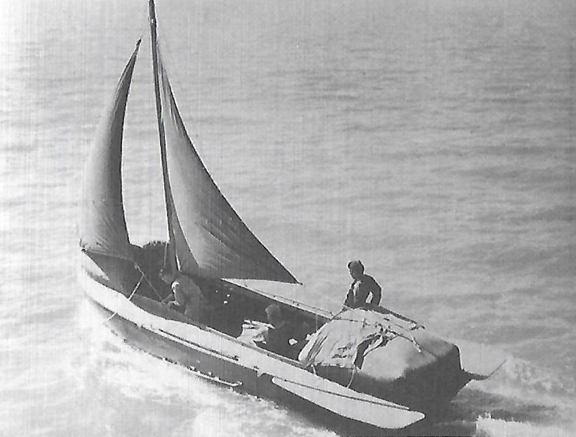
An A-1 under sail. With waterproof
compartments, even if it was swamped and turned over, it would stay
afloat. For a B-29 crew that had to ditch in rough waters off the coast of Japan on May 29, 1945, this was a life saver. After
ditching, the B-29's crew was only able to find a five-man and one-man
life raft from the B-29, which failed immediately. A B-17 found their location
and dropped a Higgins A-1 attached to three parachutes. They swam
to the A-1 and found dry clothes, blankets and other gear.
However, as the seas turned rougher, the A-1 was swamped and turned
over. It stayed afloat and the crew was able to survive by
hanging onto the straps attached to the side of the A-1. Sixteen
hours later, the crew was rescued by a submarine. When Andrew
Higgins visited Guam at the end of the war, the crew wanted to thank him
personally for being saved by his lifeboat. Unfortunately, he was
unaware of this, and did not learn about their situation until he
returned home.
Helicopters:
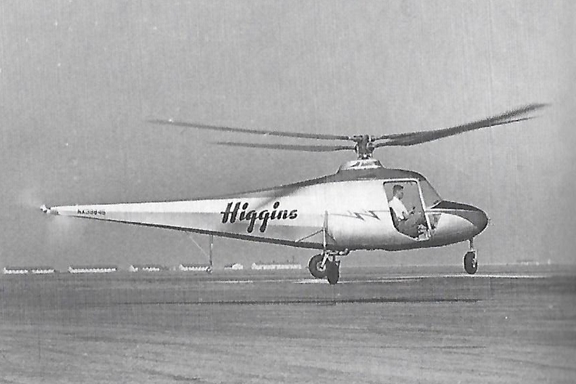
Higgins aviation also built two experimental helicopters during World
War Two. Andrew Higgins ceased work on the project after a pilot
was killed while testing
Manhattan Project Carbon Parts:
In August 1944 Andrew Jackson
Higgins was
invited to the White House for a meeting with President Franklin D.
Roosevelt. During the meeting, the President told Higgins that a
very important military project was having difficulty obtaining a
reliable supplier. For seven months, other suppliers had failed to
deliver the product to specifications. The President requested
Higgins Industries become involved in "the most vital project of the
war." The project was carbon parts for the Manhattan Project,
although Higgins and his employees were told they were parts for radio
and radar communication for security reasons. Until the Little Boy bomb
was dropped on Hiroshima in August 1945, the 2,500
employees making the carbon parts at Michoud were unaware of the
importance of their work.
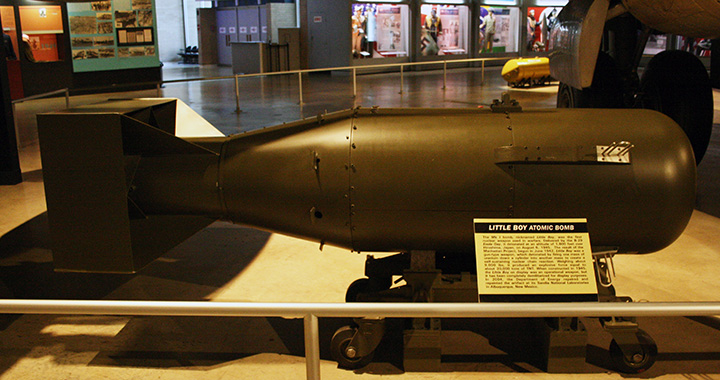
Higgins Industries did not make anything
that went in the weapon itself. Instead, the carbon parts were
used in the equipment to separate the fissionable U-235 from U-238.
This replica of the Little Boy bomb that was dropped on Hiroshima needed
132 pounds of U-235. Author's photo.
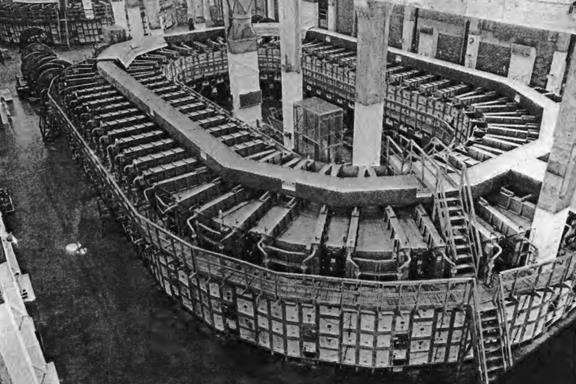
This is one of the many electromagnetic
racetrack separation machines in the Y-12 plant at Oak Ridge, TN.
Higgins' 2,500 employees at Michoud worked ten hours a day, six days a
week to keep up with the increasing demand for the carbon parts as the
Y-12 plant expanded and brought new machines online. Over the
1944-45 holidays, the Michoud employees worked Christmas and New Year's
days.
Higgins Plastics:
Truck Remanufacturing:
The remanufacture of the trucks was done in the Michoud plant.
Table 6 - Higgins
Plastics Incorporated Remanufactured Trucks
Accepted by Detroit Ordnance, US Army
The information below comes from "Summary Report of
Acceptances, Tank-Automotive Material, 1940-1945."
Published by Army Services Forces, Office, Chief of
Ordnance-Detroit, Production Division, Requirements and
Progress Branch,
January 21, 1946. |
|
Type Truck |
1944 |
1945 |
Total |
| 1/4-ton 4x4
Command |
170 |
1,680 |
1,850 |
| 2-1/2-ton
6x6 LWB w/w |
|
187 |
187 |
| 2-1/2-ton 6x6 SWB
w/w |
|
17 |
17 |
| 2-1/2-ton 6x6 SWB
wo/w |
|
37 |
37 |
|
Total |
170 |
1,921 |
2,091 |
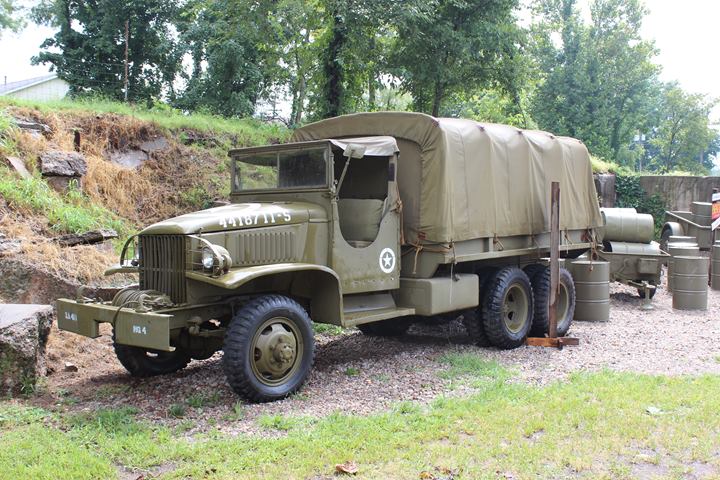
Among the 2,091 trucks that Higgins Plastics remanufactured, 187
were 2-1/2-ton 6x6 long bed GMC-353s with winches. Author's Photo.
PT Boat Gun Turrets: Higgins
made a number of PT boat turrets.
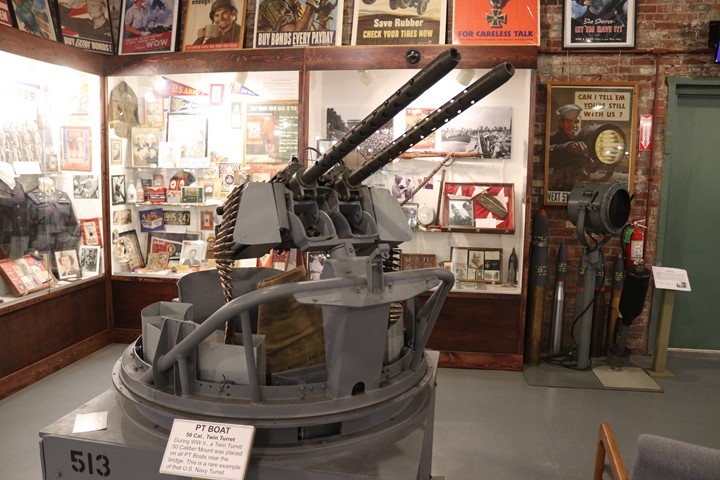
This PT boat gun turret is on display at the Indiana Military Museum
in Vincennes, IN. I was not able to find any manufacturer's
identification on it. Higgins may have built it. If not, the
Higgins-built units were very similar to this. Author's Photo.
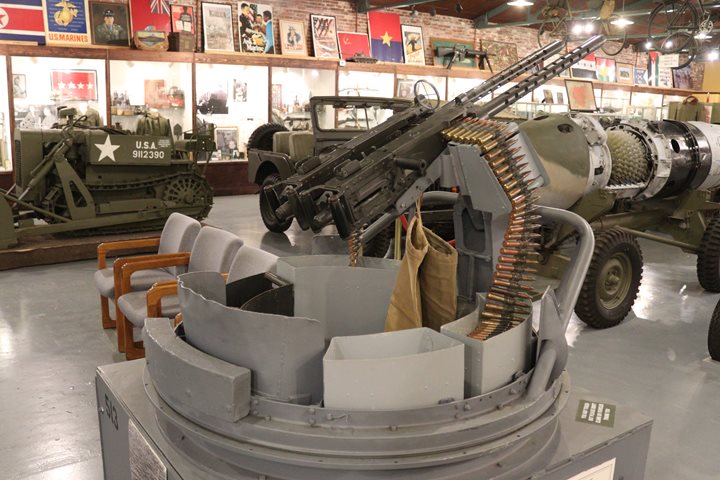
Author's Photo.
Landing Craft Personnel, Large (LCP(L)) -
The Eureka Boat - Andrew Jackson Higgins applied for a patent on
December 24, 1937 for the design of the hull of what became known as the Eureka Boat. This same hull design then carried over
to the later landing craft designed by Higgins and Higgins Industries.
It was patented on January 17, 1939 with US Patent Number 2,114,111.
This was also referred to as the Eureka Boat as it was based on an
experimental boat by Higgins with this name. Unfortunately, the
term Eureka was sometimes used as a generic term for the other three
landing craft Higgins designed using this patented hull configuration.
This makes it difficult to understand exactly which landing craft is
being referenced.
US Patent Number
2,114,111
Shown here is the only known restored
surviving Higgins-built LCP(L). It is on display at the National
Museum of World War Two in New Orleans, LA, and was built five miles
away at the former Higgins City Park Plant in October 1944. The
date of manufacturer of October 1944 may seem strange. By this point
in the war the LCVP was the desired
landing craft with the big ramp on the front for easy troop egress.
However, there was still a demand for a good solid work boat that could navigate shallow waters and
carry four tons of cargo or 25 troops. That kept the LCP(L) in production to
the end of war. In the Pacific during invasions the LCP(L)s were
used as control boats by the navy.
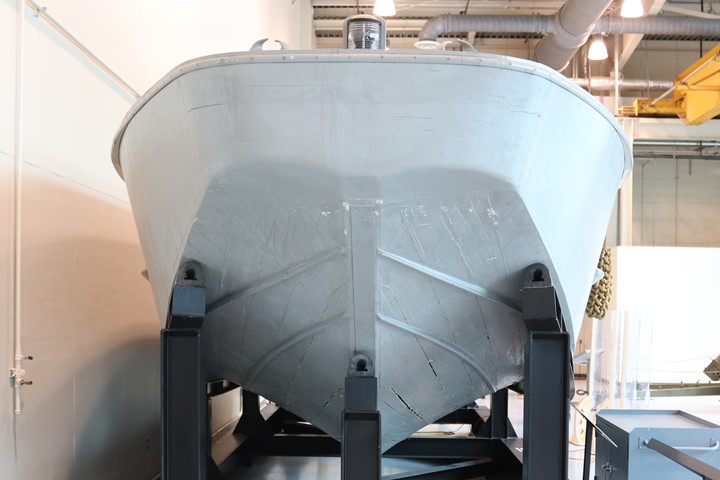
According to the "Higgins Biography," the
U.S. Navy changed the design of the hull when they accepted the boat.
This example has a flatter bottom front section than the V-shaped Eurekas
that Higgins was selling to the British. In U.S. Navy tests, the
flatter front section allowed for faster retraction from the beach while
still meeting the Navy's speed requirement. Author's Photo.
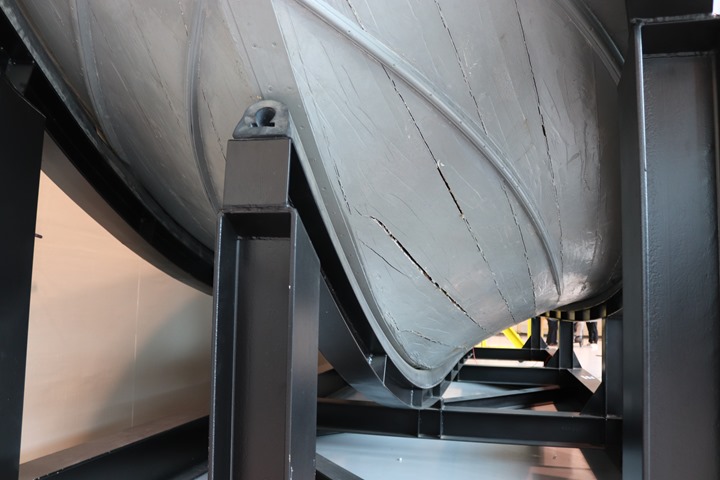
Author's Photo.
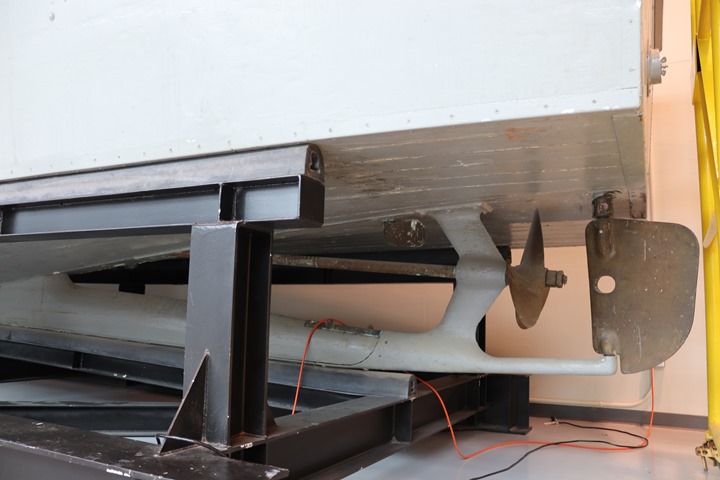
There is a hole in the rudder, so when
it is turned 90 degrees, the propeller shaft can be pulled out after the
propeller is removed. Author's photo.
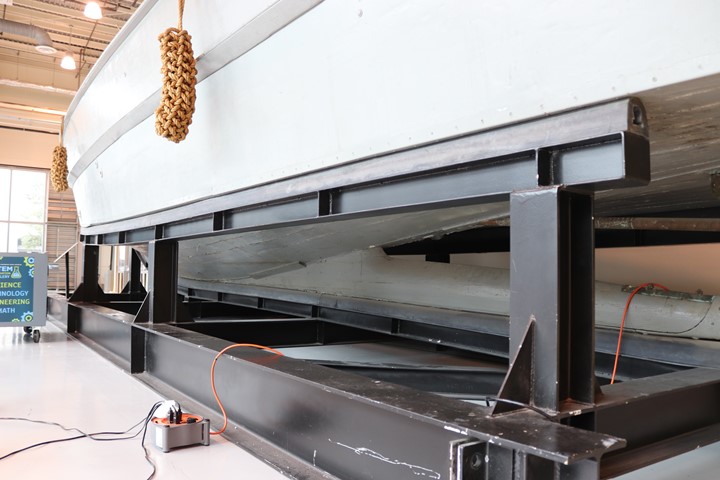
Author's Photo.
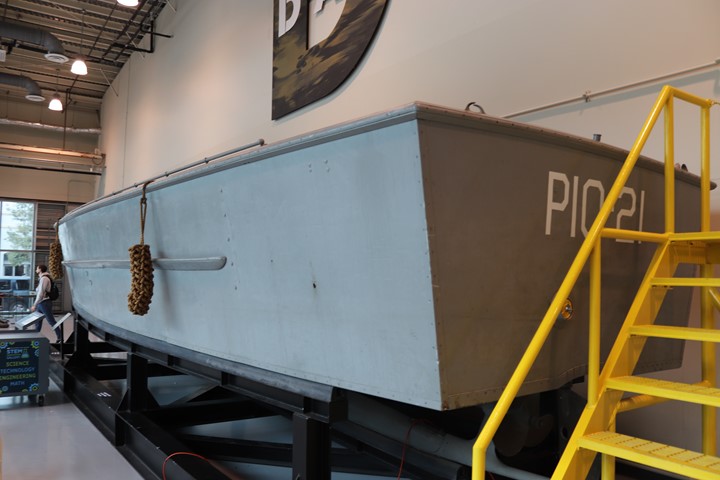
According to a Higgins engineering drawing
in the December 1941 Operators Manual, Eureka landing boat, the LCP(L)s
of that era were built with rounded stern chines. The design
changed as the war progressed. Author's Photo.
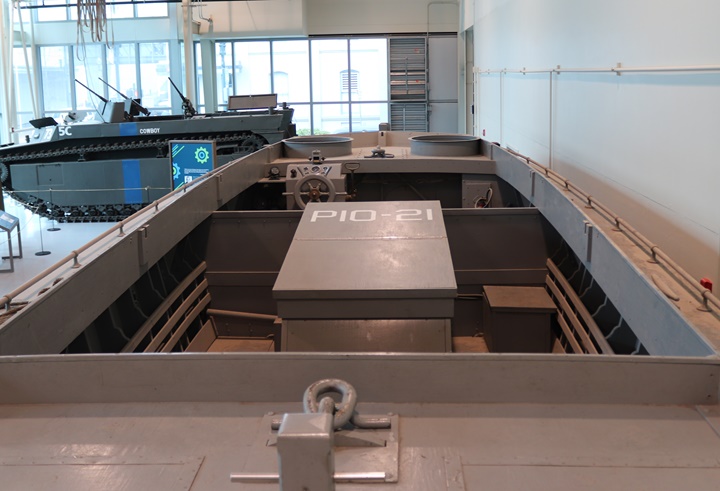
Note the location of the coxswain's steering
station and the two gun tubs for mounting self-defense machine guns.
Note also that the 25 armed troops the craft could carry were in two
different sections of the boat. Author's Photo.
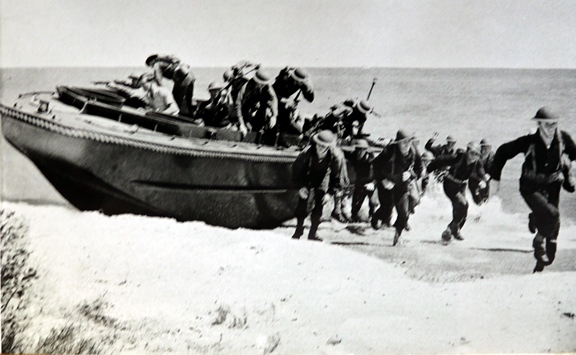
This photo from "History in a Hurry" shows
that the LCP(L) could get the troops up on the beach, but they still had
to jump over the gunwales to exit the boat.
The following engineering drawings are from
the "Operators Manual, 36-foot "Eureka" Landing Motor Boats," Revised
June 1944 by Higgins Industries.
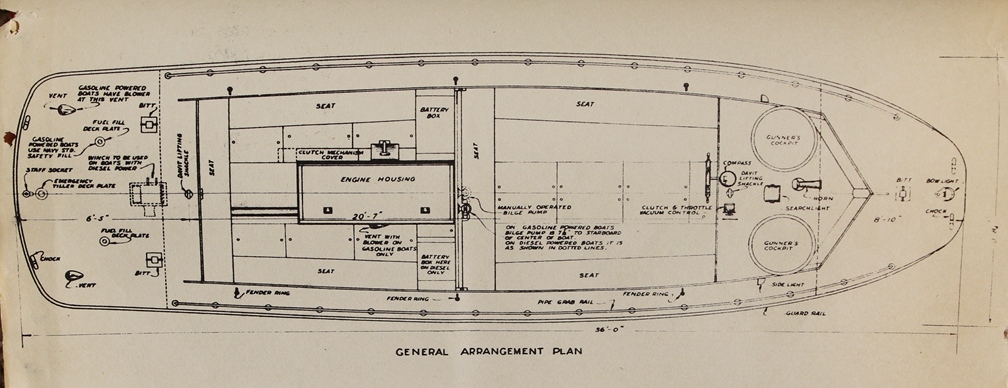
This undated drawing shows the LCP(L) with
the rounded aft chines. The early LCP(L)s and LCVs came with the
rounded chines. At some point in the war Higgins went to the hard
chines. Drawing added 2-15-2020.
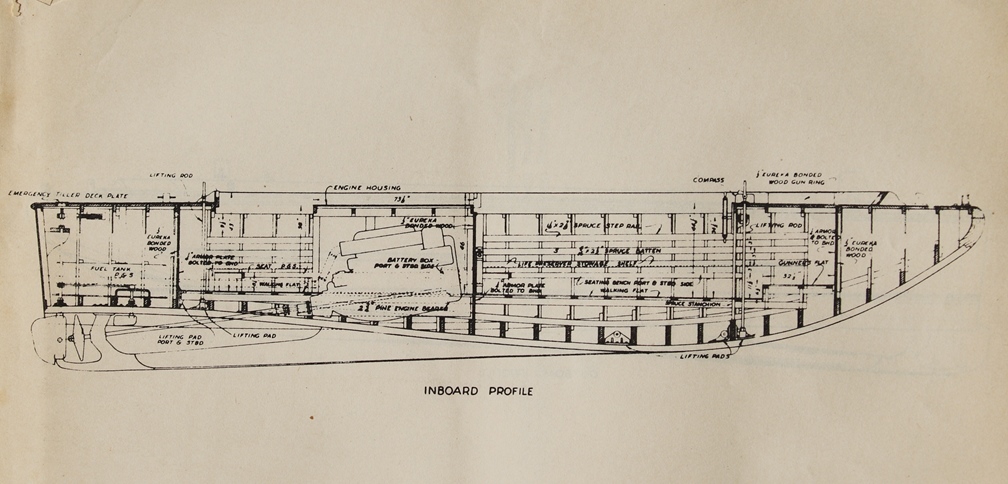
Drawing added 2-15-2020.
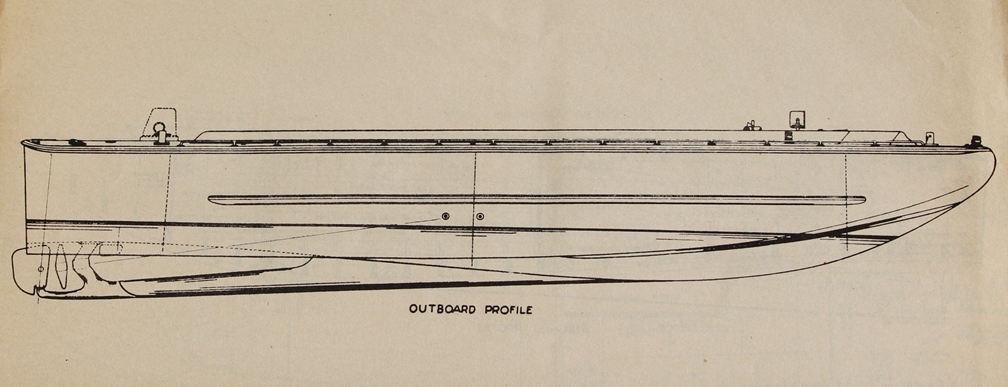
Drawing added 2-15-2020.
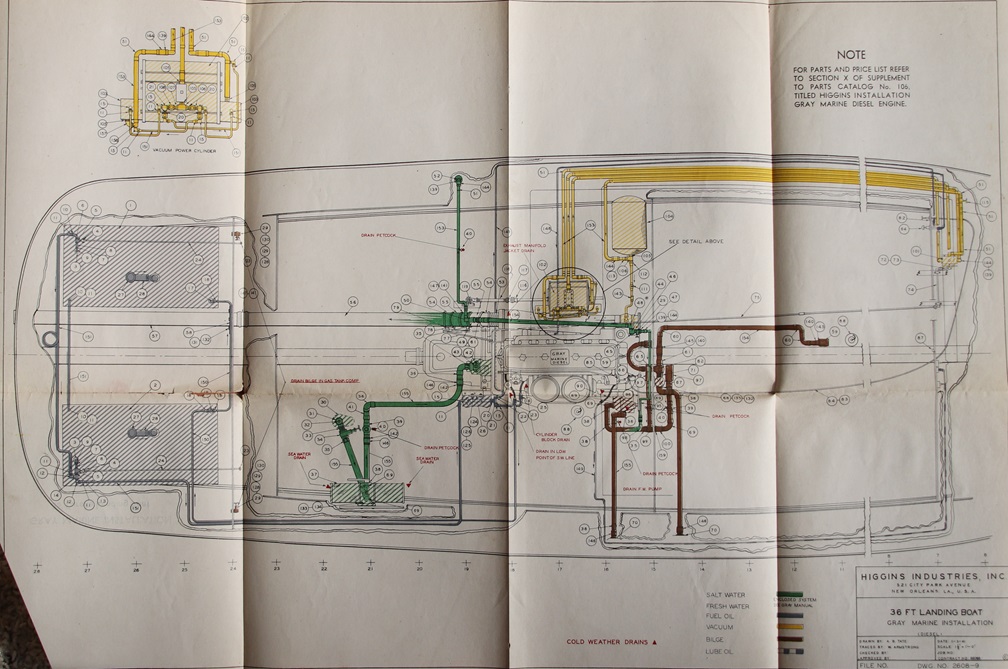
This drawing dated 11-3-1941 shows the
plumbing for a Gray/Detroit Diesel engine installation for the LCP(L).
It has the rounded chines. Drawing added 2-15-2020.
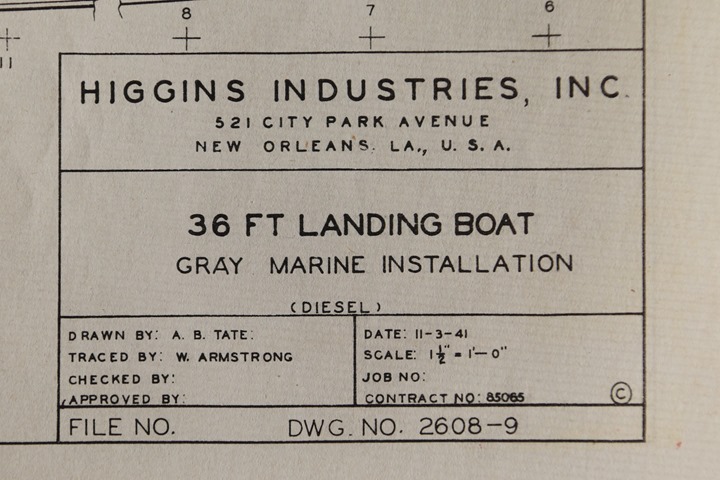
Drawing added 2-15-2020.
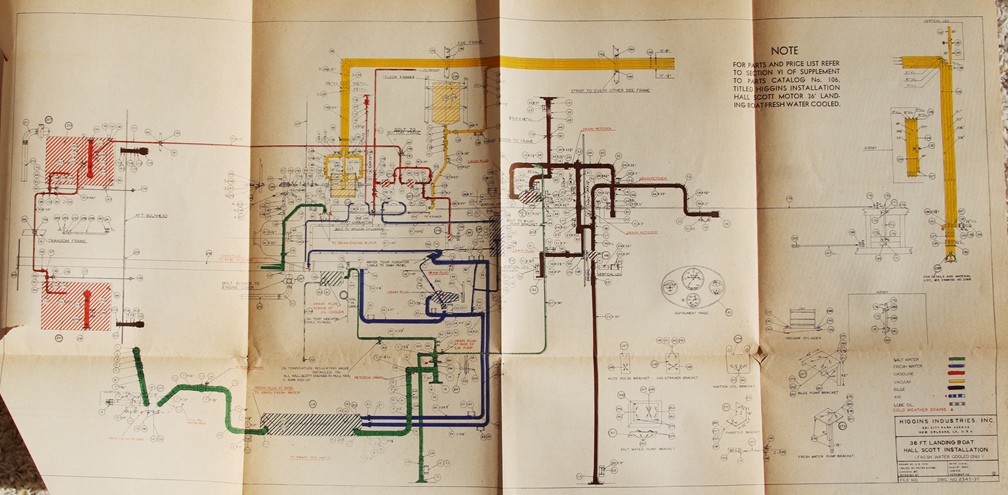
This drawing dated 11-4-1941 shows the
plumbing for a Hall-Scott Invader engine with fresh water cooling for
the LCP(L). Drawing added 2-15-2020.
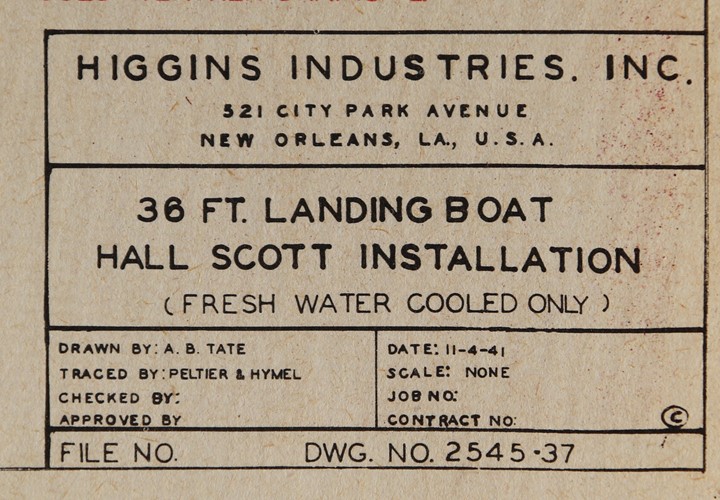
Drawing added 2-15-2020.
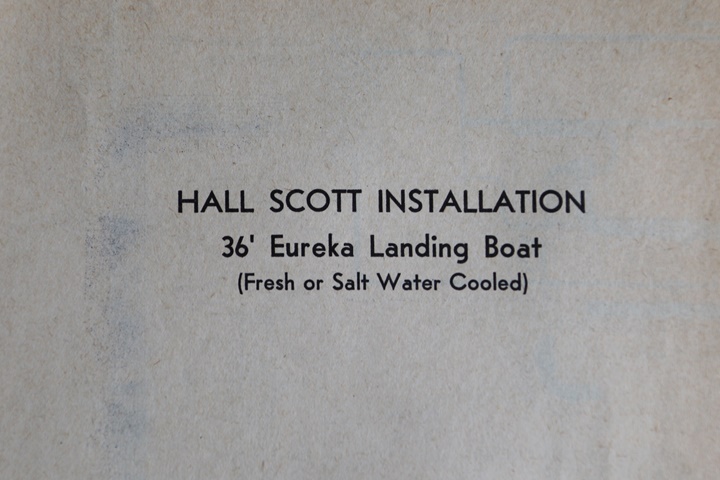
Image added 2-15-2020.
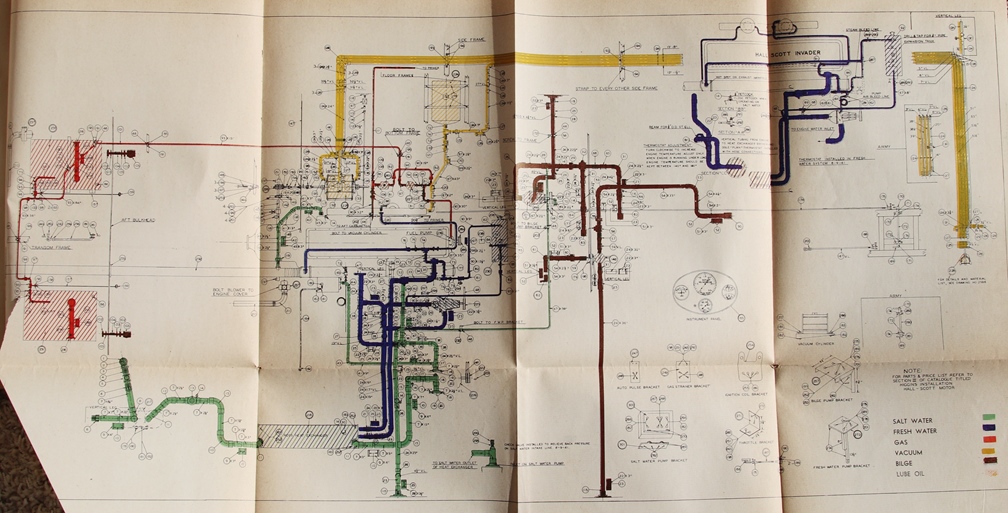
This drawing is undated, but probably from
the same time period as above. This would be early November 1941.
Salt water cooling of boat engines was the norm previous to World War
Two. However, the U.S. Navy in its requirements for the Higgins
designed landing craft called out for fresh water cooling with a heat
exchanger. Drawing added 2-15-2020.
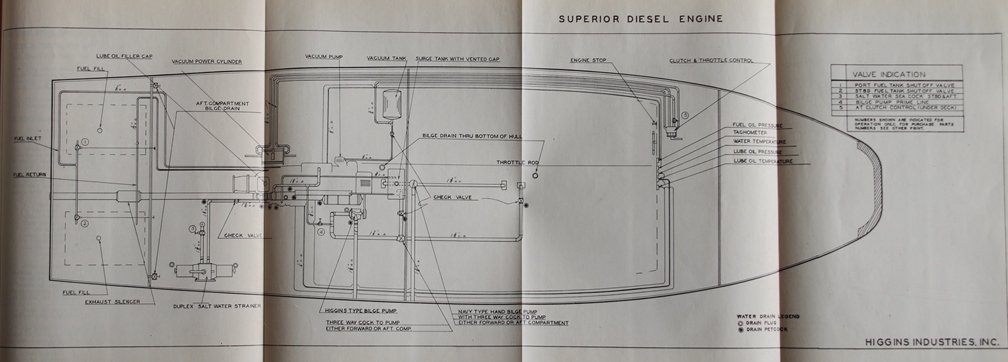
A Superior Gas Engine Company of
Springfield, OH had a diesel that was also specified as an engine for
the LCP(L) as shown in this undated drawing. This was the Superior
Model SMRA-4 four-cylinder, four cycle diesel engine that produced 150
hp @ 2400rpms. Note that this drawing shows the hard chine on the
rear of the boat. Drawing added 2-15-2020.
Landing Craft, Vehicle (LCV) -
In June 1941 Higgins at the request of the Navy designed a Eureka boat
with a ramp. To make the prototype of the ramped Eureka boat,
Andrew Higgins had his workers cut the front end off of an LCP(L) under construction,
and add a ramp to it. While not the most efficient way to
build the prototype, it was expedient. "Higgins Biography"
labels this as an LCVP, but this is what later in the war was
designated as the LCV. In feedback to Higgins, the Navy was
concerned about the location of the engine, the coxswain's location
on top of the stern that left him exposed to hostile fire, and the
lack of provisions for machine guns like the LCP(L) did.
There is an engineering
drawing on page 30 of "The Boat that Won the War - An Illustrated
History of the Higgins LCVP" by Charles C. Roberts, Jr., Published 2017
by the Naval Institute Press. The date of the drawing is 8-22-1942
and it is for a U.S. Navy 36 foot Ramp Type Eureka Surf Landing Boat.
The drawing shows an LCV with rounded chine on the stern. Also, on
the drawing is the Navy contract Number 697 for 600 boats with Registry
Numbers C-10755 to C-11354 Inclusive.
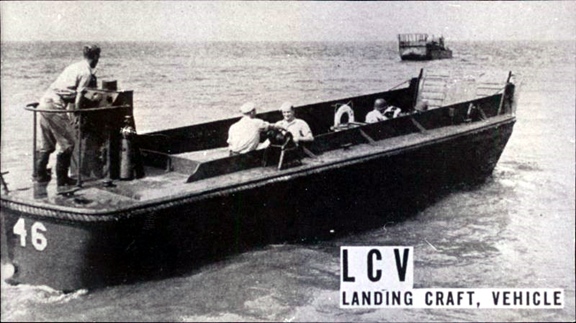
There were 2,633 LCVs built between 1941
and 1943 by Higgins Industries, Chris-Craft, Richardson, and Owens Yacht.
While not built in the
quantities of the LCVP, LCVs saw duty in early American invasions in
World War Two. It continued to be utilized even after the LCVP
became the dominant landing craft later in the war.
There are several key differences
between the original LCV and the later LCVP that can be seen in the
photo above and the outline drawing for the LCV shown below.
The most obvious is the coxswain's station, which on the transom of
the LCV. It was moved into the boat on the LCVP. Note
the ramp winch is also located in an exposed position on the port
side of the LCV. In the LVCP it was moved down into the boat
to protect the crewman operating it from hostile fire.
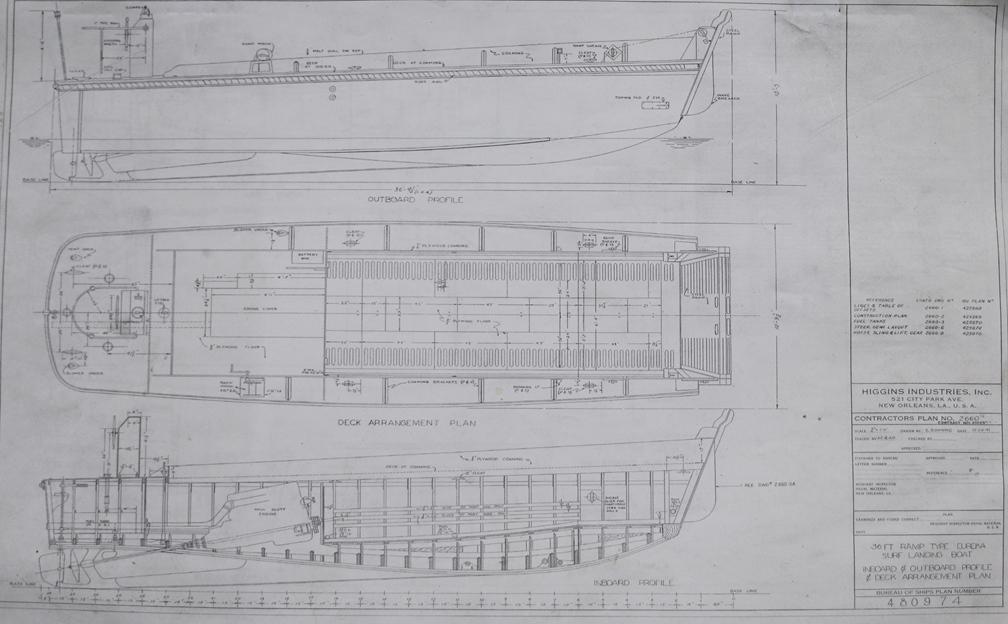
The name given to the LCV at the time of
this drawing on 12-29-1941 was 36 Foot Ramp Type Eureka Surf Landing
Boat. Engineering drawing courtesy of C. Robert Gillmor added
1-9-2020.
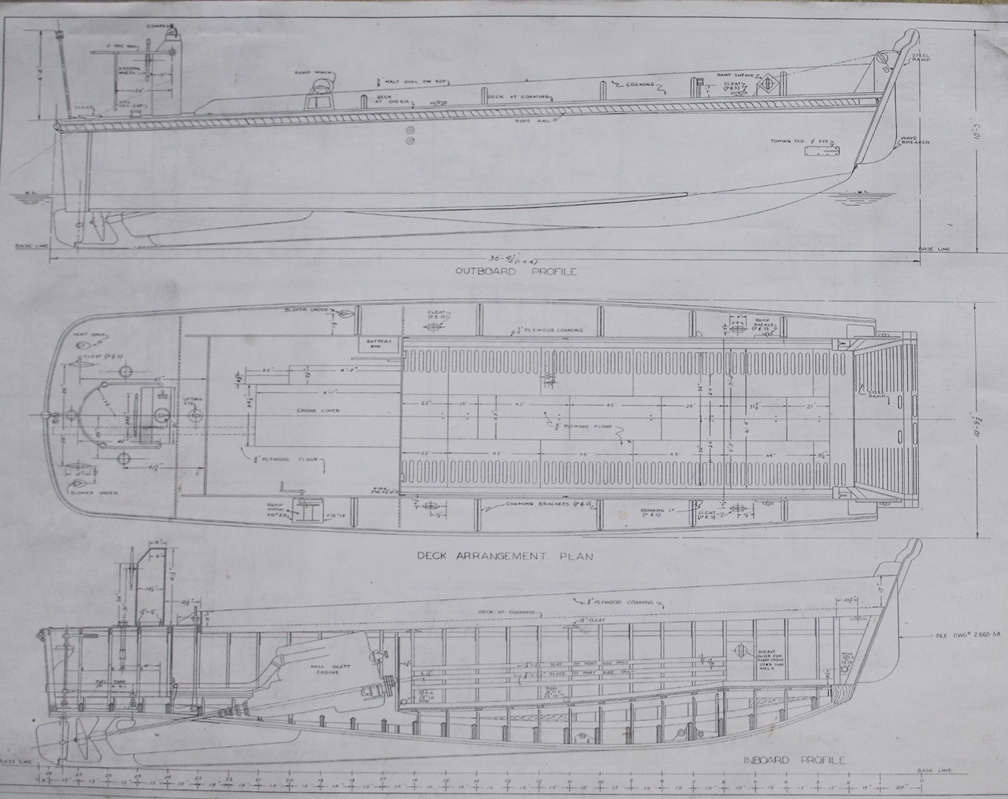
The length of the boat was 36 feet and
4-1/2 inches. It was 10 feet and 9 inches in height, and 10
feet and 9-1/2 inches wide. The engine shown is a Hall-Scott
168 Invader six-cylinder gasoline powered engine. Engineering
drawing courtesy of C. Robert Gillmor added 1-9-2020.
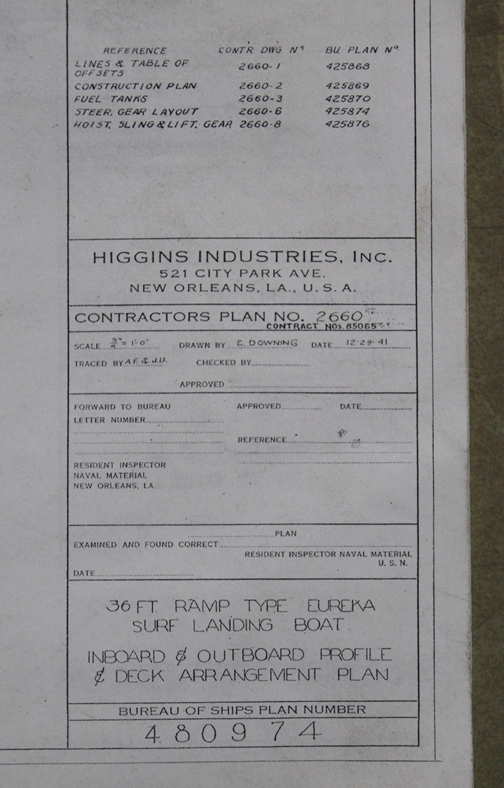
C. Downing drew this engineering drawing
of the 36 Foot Ramp Type Eureka Surf Landing Boat on 12-29-1941.
Note that it was neither checked nor approved. Engineering
drawing courtesy of C. Robert Gillmor added 1-9-2020.
The following engineering drawings are from
the "Operators Manual, 36-foot "Eureka" Landing Motor Boats," Revised
June 1944 by Higgins Industries.
The two drawings below for a Hall-Scott Invader installation for fresh
water cooling and both fresh and salt water cooling are most
interesting. If I am reading the drawings correctly, the
Hall-Scott engine is in the rear of the boat with the drive end of the
engine facing towards the bow of the boat. The driveshaft runs
into what I assume is a transfer case that supplies the power to the
propeller at the stern. These drawings are dated September and
October 1941, 2-3 months before the drawings above that are dated
12-29-1941. It appears that the LCV was originally intended to
have the engine in the stern of the boat and a transfer case to provide
power to the propeller. The drawings of 12-29-1941 above show the
engine amidships with the drive end of the Hall-Scott Invader engine
facing the rear to for direct drive to the propeller. All of the
photos I have seen of the LCV show the engine amidships directly
supplying power directly to the propeller.
There is mention in the literature of the navy being unhappy with the
original location of the engine in the LCV. This may be the reason
for the sudden change. If this is so, then there is the question
of why a 1944 operator's manual has obsolete drawings in it.
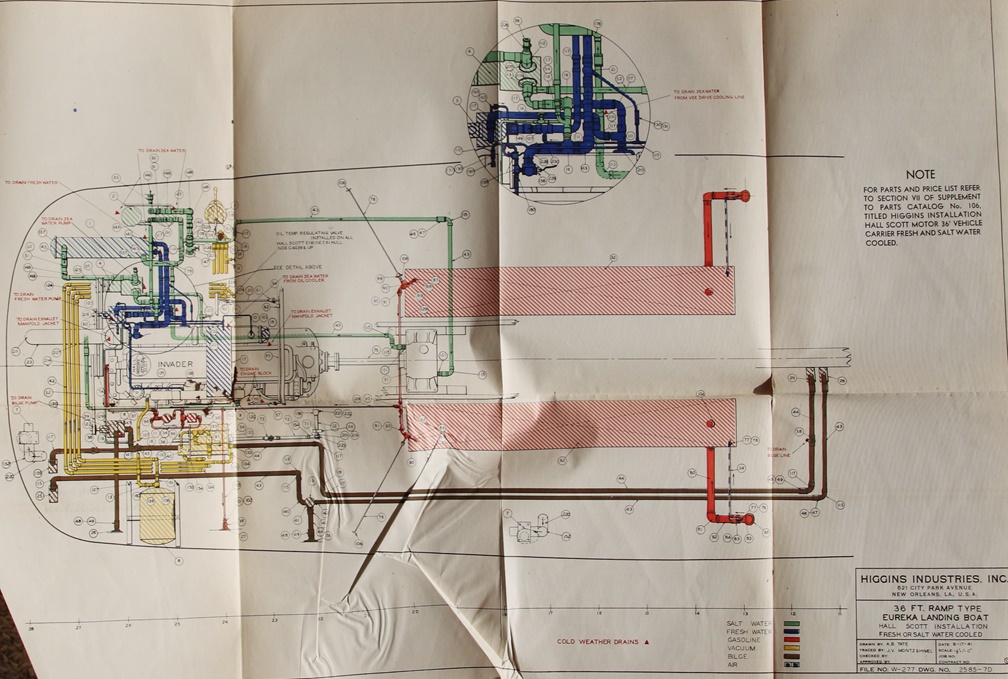
This and the drawing below both
have the soft chines on the rear of the boat. Drawing added
2-15-2020.
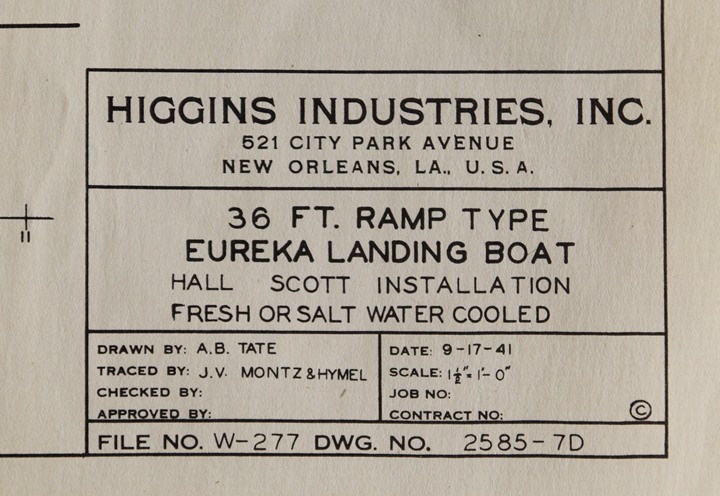
Drawing added 2-15-2020.
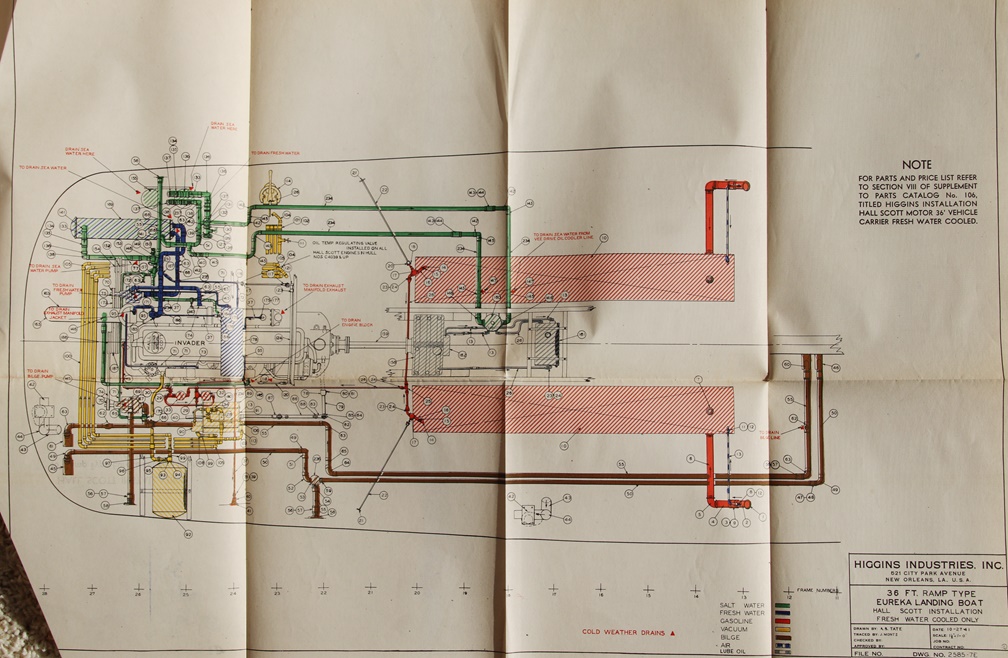
Drawing added 2-15-2020.
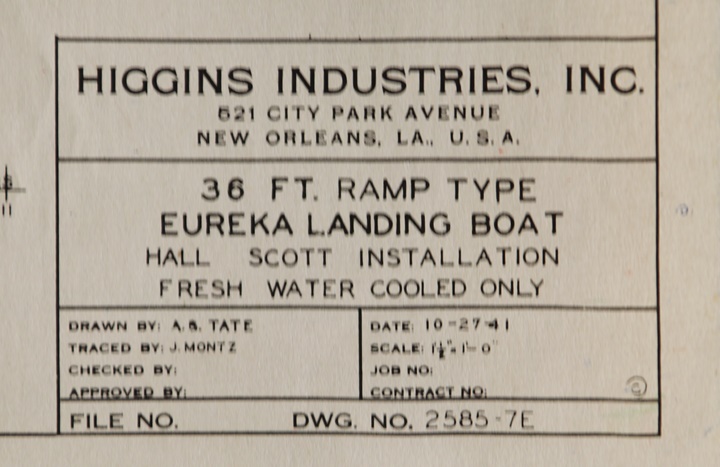
Drawing added 2-15-2020.
Landing Craft, Vehicle, Personnel (LCVP):
The LCVP was a great improvement,
allowing for a quicker discharge of the troops onto the beach compared
to the LCP(L) and the LCP(R). In August 1942, tests were
performed by the Amphibious Command of the U.S. Corps of
Engineers to determine how long it took for 36 fully equipped troops
to exit the LCP(L), the LCP(R) and the LCVP.
|
Table 7 -
Results of test for determining how quickly troops can depart a
landing craft |
|
Landing Craft |
Results (Seconds) |
Comments |
| LCP(L) |
57 |
Soldiers had to jump over the gunwales as shown in the photo
above. |
| LCP(R) |
32 |
Soldiers have to exit single file. |
| LCVP |
19 |
|
|
Table 8 - Higgins
Industries built LCVP Registry Information - Partial
The information below comes from "The Boat that Won the War - An
Illustrated History of the Higgins LCVP" by Charles C. Roberts,
Jr., Published 2017 by the Naval Institute Press.
Mr. Roberts obtained several original Higgins 36 Foot Landing
Craft LCVP engineering drawings from the National World War II
Museum in New Orleans, LA for use in his book. Also, the
first line of data comes from Mr. Robert's Website; http://www.robertsarmory.com/Higgins-Boat.htm.
These drawings have provided the information below. The
data is incomplete, but does provide more than was known before. |
|
Date of Drawing |
Title of Drawing |
U.S. Navy Contract Number |
Registry Numbers |
Number of LCVPs |
Type of Stern Chines |
Page No. in Book |
Comments |
|
Before July 1943 |
N/A |
Unknown |
C-32238 |
3,600 |
Round |
N/A |
From
the website. Mr. Roberts has Higgins LCVP Registry C-32238
which was one of 3,600 boats built between February-April 1943.
It came with rounded chines on the stern, but was later changed
to a sharp chine. |
| July
9,1943 |
General Arrangement and Profiles |
None |
None |
|
Sharp |
31 |
|
| May
17, 1944 |
Ramp,
Hoisting Gear Layout |
1222 |
C-39071 thru C-41670 Inclusive |
2,600 |
Round |
57 |
|
| " |
" |
" |
C-54847 thru C-55046 Inclusive |
200 |
Round |
" |
|
| " |
" |
" |
C-69664 thru -70663 Inclusive |
1,000 |
Round |
" |
|
| " |
" |
" |
C-70999 thru C-71598 Inclusive |
600 |
Round |
" |
|
|
February 13,1945 |
Framing |
None |
None |
|
Sharp |
41 |
|
| April
17, 1945 |
General Arrangement and Profiles |
1950 |
C-77944 thru C-78678 Inclusive |
750 |
Sharp |
31 |
This
same information is on a drawing dated March 31. 1945, for
a 36 FT. Landing Craft LCVP Lines and Table of Offsets. |
| " |
" |
2009 |
C-81554 thru
C-82528 inclusive |
975 |
Sharp |
" |
|
|
Total |
|
|
|
9,725 |
|
|
|
Analysis: While
not complete, the information above does give some insights into Higgins
LCVP production. Three US Navy contract numbers are listed, along
with the 6,125 Registry numbers built under the contracts, although not
all boats on contracts 1950 and 2009 may have been built by the end of
hostilities. Also, it shows that Higgins apparently changed back
and forth on the type of chines it installed on the stern of the LCVPs.
The original LCVPs were built with the round chines, but Higgins later
changed to the sharp chines when other manufacturers began production.
This was apparently because the other companies could not do the rounded
version. This may or may not be true. The other companies
may have requested this because it was easier and cheaper to build.
This would have also made for faster LCVP production. The
data shows that in 1943 Higgins had sharp chines on the prints, then in
1944 rounded chines, and then in 1945 it returned to the sharp chines.
It is unknown why the company was switching back and forth. The
LCVP below is a rounded chine version, one of 4,400 built under US
Navy contract 1222. The LCVP, like several of
other World War Two weapons, continued to be built after World War Two.
It was a good solid design, and 1,465 36-foot wooden LCVPs were built
for the U.S. Navy from 1950 through 1962. Between 1965 and 1969
452 fiberglass versions were built from 1950 to 1969. This,
along with the Jeep. may have very well been the longest lasting design built into the Vietnam
War era. Higgins did not build any of the
post-World War Two LCVPs.
That raises the question
of why were there new LCVPs built. No doubt because they those
that were kept in service after World War Two were wearing and
rotting out. Replacements were needed. This then casts
doubts on museums and individuals that have LCVPs and do not have
any C- number to identify who or when it was made. Many of the
LCVPs in museums being identified as World War Two-built are more
likely to be the newer post-war built boats.
Known Surviving Higgins-built LCVPs:
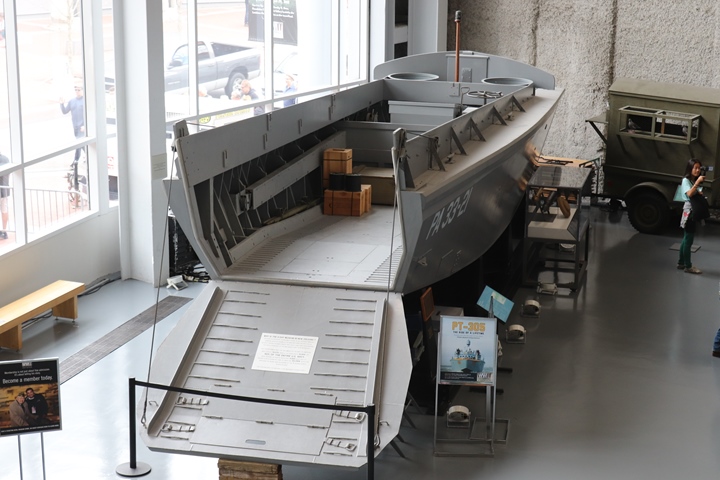
This is not a surviving Higgins-built LCVP.
It is a replica that the National World War Two Museum in New Orleans,
LA had built and is now on display at the entrance to the museum.
What is interesting about this replica is that it is not like any of the
known LCVPs I have looked at or the known Higgins boats shown below.
See the photo below for more details. Photo added 2-15-2020.
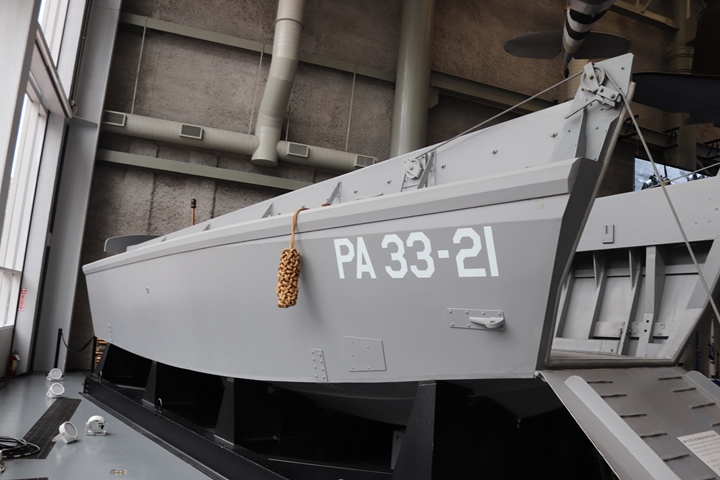
Note that towards the bow the side of the
boat is not flat and there is a sharp angle were it changes. All
of the LCVPs I have looked to date in several different museums all have
flat sides. This one does not have any armor plate and the molding
along the edge of the side of the boat and the gunwale is a lot
different than on those that I have seen. Photo added 2-15-2020.
In looking at the LCVPs below, note they all
have flat sides.
Theoretically, there are around twelve known original World War Two LCVPs left in the
world. Assuming for a moment they are, and that is doubtful
based on lack of documentation or C-numbers, Higgins did not built them
all. Based on the fact that Higgins built approximately 60%
of the LCVPs during World War Two, seven should be Higgins built. To date, only two have been verified
as World War Two era, and both are Higgins-built LCVPs. The one shown below
is owned by three members of the Ohio Motorpool in OH. The photos below were
taken at the 2017 Military
Vehicle Preservation Association National Convention, Cleveland, OH.
This LCVP sat in a barn from 1948 to 2012.
Because it was put in storage, and never used as a tourist or fishing
boat, unlike many others on display, it is original. Nor was it
kept by the Navy and then modified. The first set of photos below
show it in its original condition before restoration.

This is a real 1944 Higgins Industries built
LCVP looking no doubt very much like it did in 1947 when it was shipped
from Mississippi to a farmer in Illinois. There is no need for
extensive restoration, as it was in a barn for 65 years. Author's
photo.
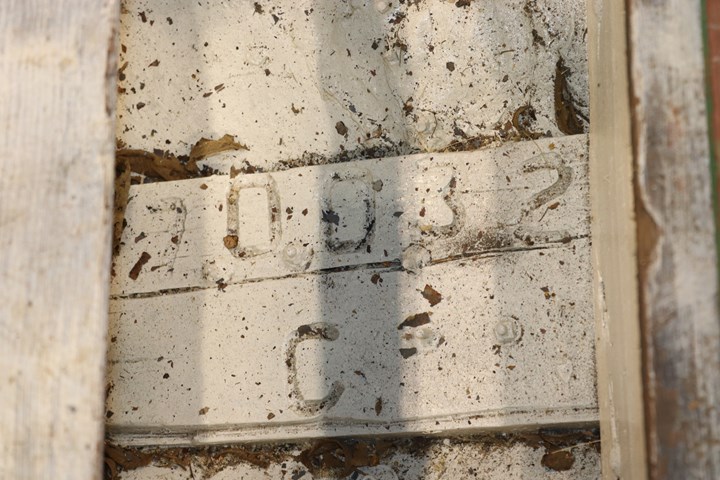
The boat's registry number of 70032 is imbedded in the wooden structure.
Unless other LCVP owners can produce registry numbers like this, there
is no direct way to discern whether their boats are World War Two or
post-World War Two-built. Author's
photo.
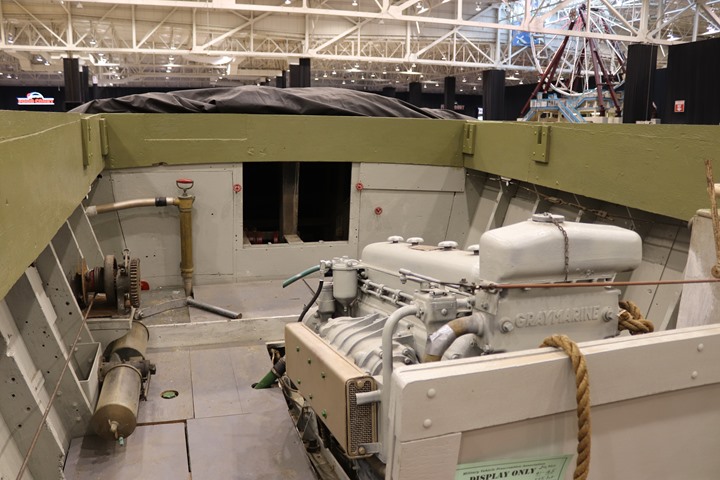
The Gray Marine name can be seen on the heat
exchanger in front of the Detroit Diesel 6-71 engine. This is the
connection between the American Automobile Industry in Detroit, MI, and
the largest manufacturer of small boats during World War Two in New
Orleans, LA. The preferred engine for the LCVP and other small
landing craft during the war was the Gray/Detroit Diesel 6-71 engine.
When it was not available, in many cases the replacement was a gasoline
marine engine from a manufacturer in Detroit. Author's
photo.
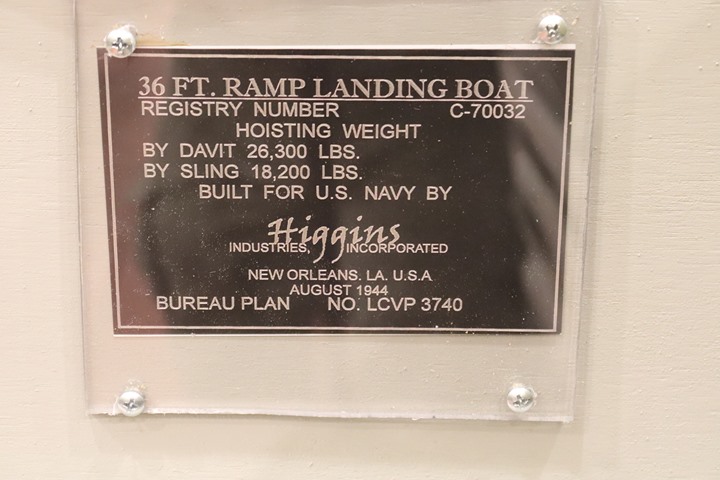
Author's photo.
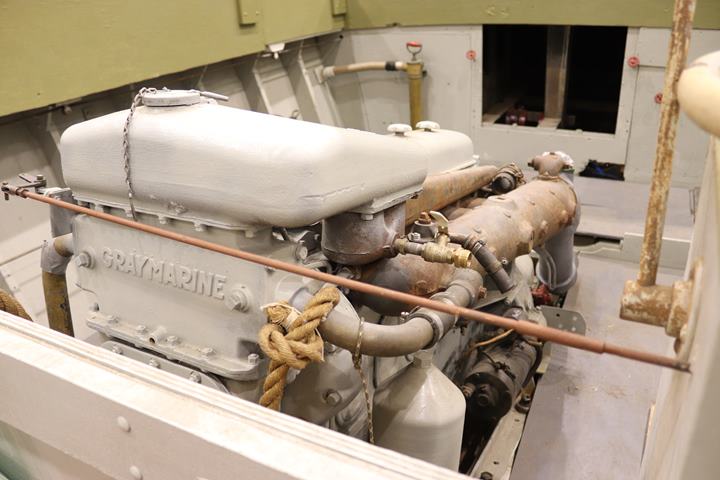
Author's photo.
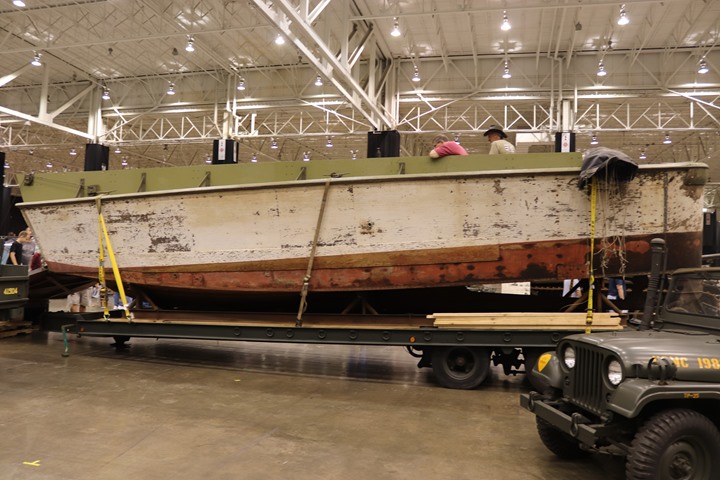
Author's photo.
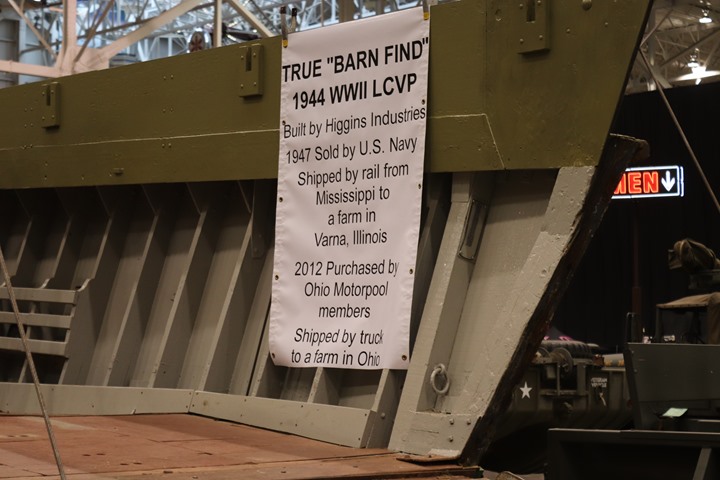
The National World War Two Museum in New
Orleans missed out on this. I asked the Ohio Motorpool person at
the show what the WWII Museum thought when they found out about this
LCVP. He told me that they visited it before the Ohio Motorpool,
and couldn't figure out how to get it out the front of the barn, as
there were interferences. So, they left. The Ohio Motorpool
went to Illinois and determined if they took the back of the barn off,
they could take it out that way. It would have to go across the
neighbor's property and some trees on that property would have to be cut
down. The neighbor agreed, and the Ohio Motorpool ended up with,
in my estimation, the most important original LCVP in existence because
it was built by the same company that designed it. Author's photo.
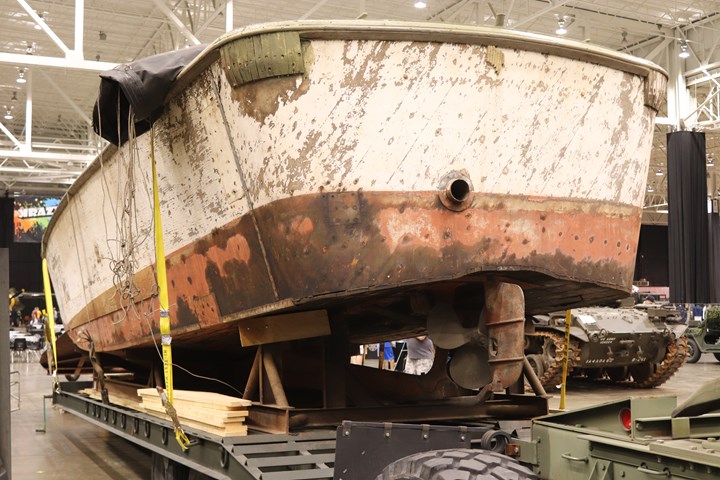
The rounded soft chines on the stern
indicate this is a Higgins-built boat. But there is confusion
and mystery in reference to this type stern. Supposedly other
manufacturers could not build the rounded corners, and a design change
was made to build the LCVP with squared corners. Author's photo.
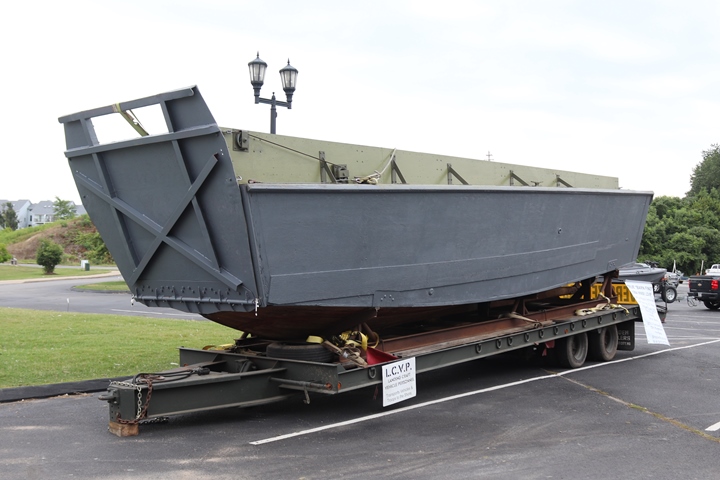
This is Higgins-built LCVP 70032 after
restoration. This was photographed at D-Day Conneaut, OH in August
2019. Author's photo added 1-9-2019.
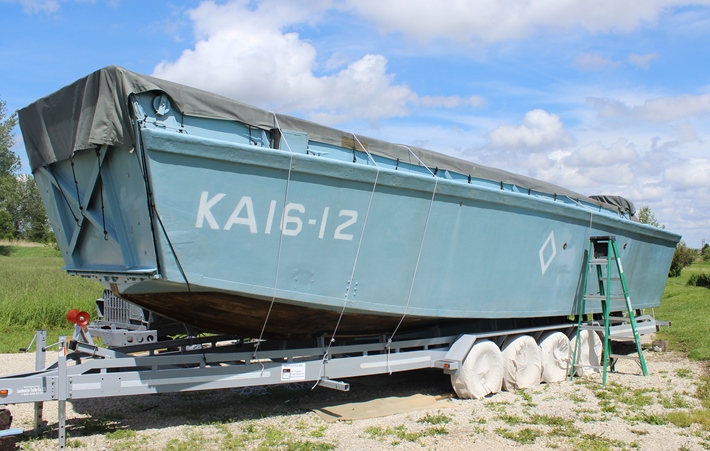
This is the second known Higgins-built LCVP, owned by Roberts Armory in Rochelle, IL. It is
registry
number 32238. This had several post-WWII modifications to it.
Author's photo.
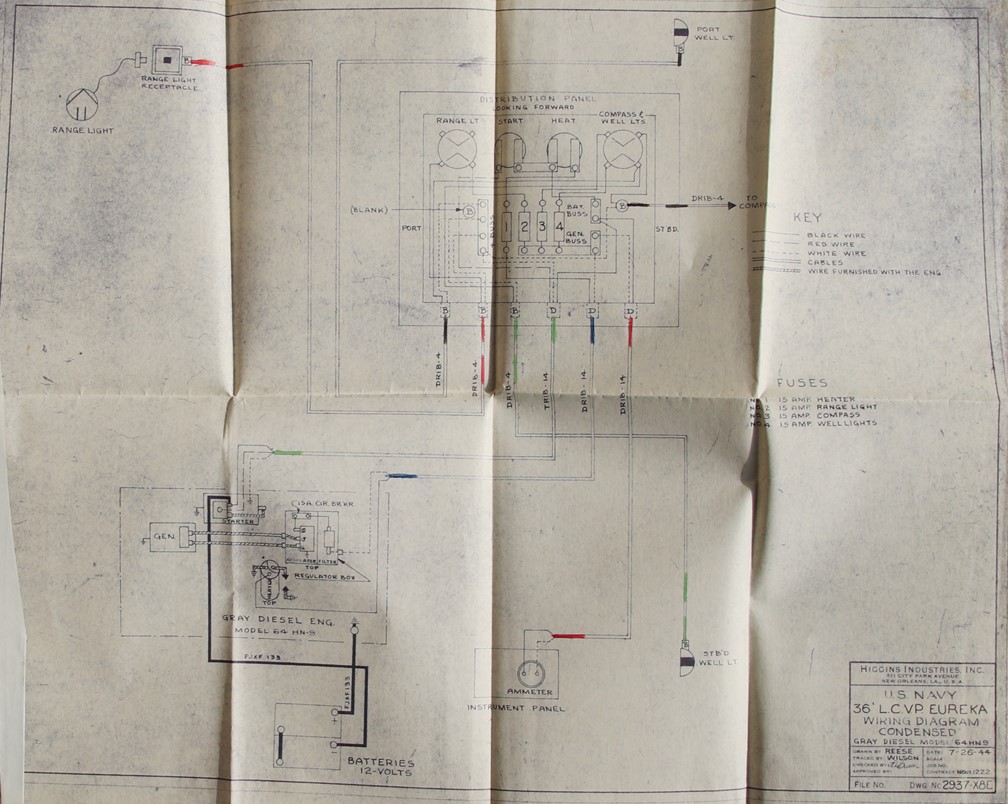
Drawing added 2-15-2020.
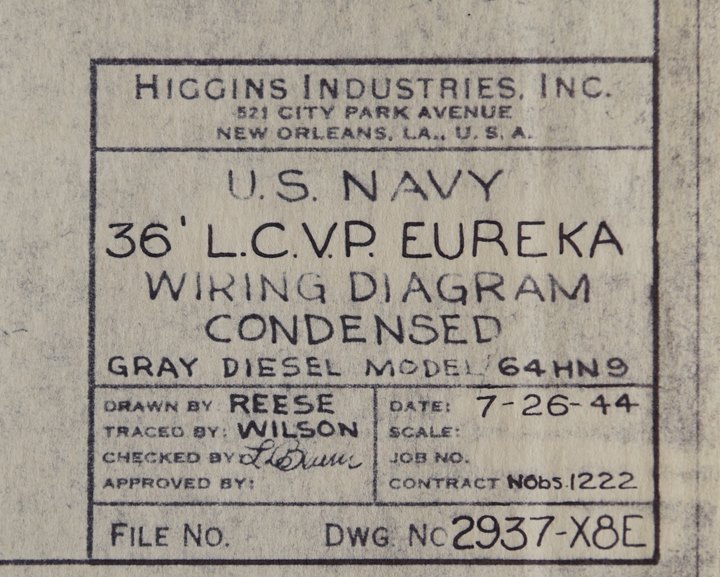
Drawing added 2-15-2020.
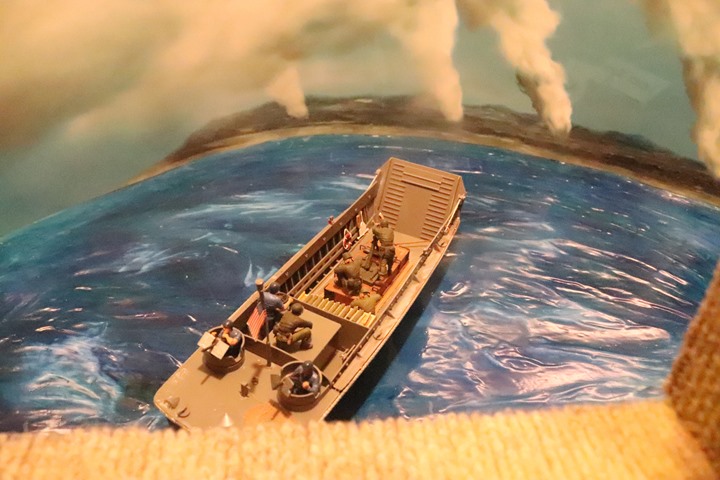
This model LCVP and diorama is at the US
Army Chemical Corps Museum at Fort Leonard Wood, MO. It shows how
the Army Chemical Corps used the LCVP to fire smoke from 4.2 inch
mortars during beach invasions. Author's photo.
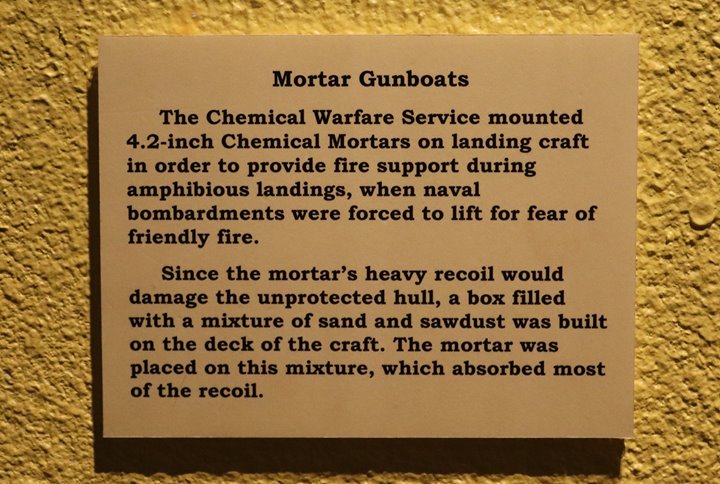
Author's photo.
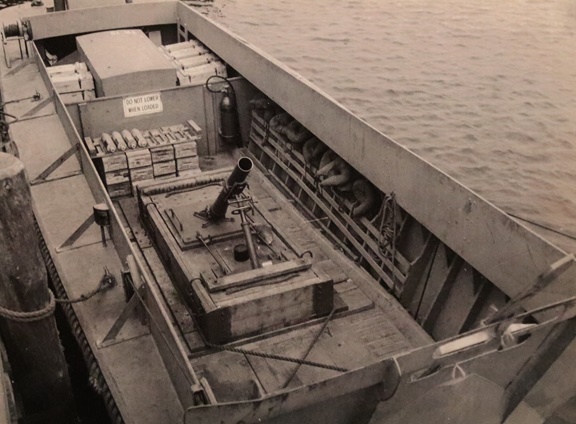
This is an LCV with a mortar in it.

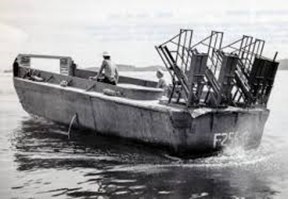
This photo shows an LCVP being used as a
rocket launcher.
LCVP Landing Ramp Hoisting Gear Layout: There were several
ways cables ran to drop and lift the ramp at the front of the LCVP. Some may have been design changes made by Higgins. Othierwise, one of the
other manufacturers of the LCVP may have run the cables differently than
the drawings called for. The original method was a carryover from
the LCV which had the winch located on the starboard side gunwale.
One cable ran forward from the winch along the inside of the boat and
then connected to two cables. One cable ran to the starboard side
of the ramp while the other cable ran under the floor of the boat.
It then came back up and attached to the port side of the ramp. A
latter version moved the winch to the deck on the inside of the boat, as seen in the
drawings below. The only difference between this latter version
below and the original is the location of the winch. The routing
of the cables was the same.
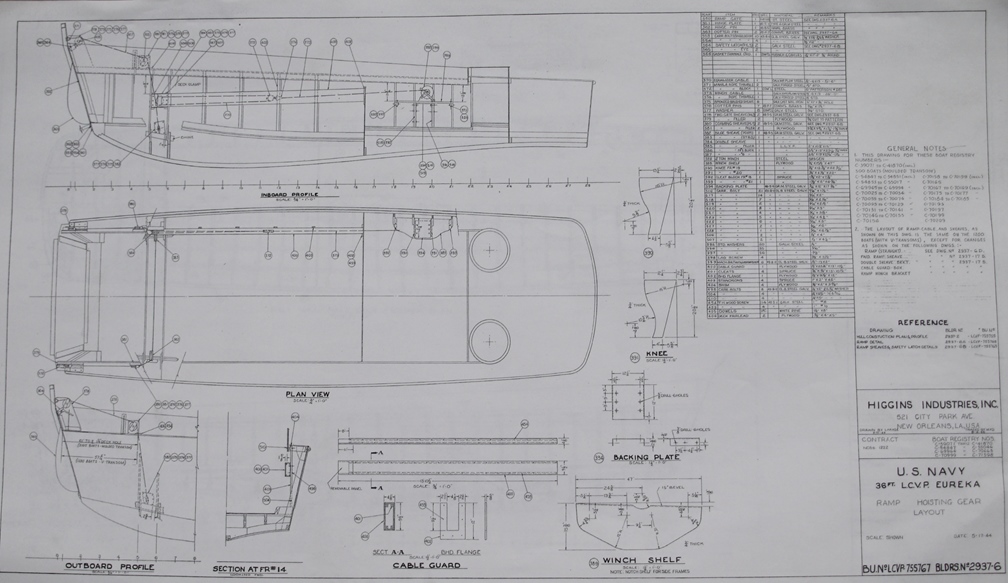
Engineering drawing courtesy of C. Robert
Gillmor added 1-9-2020.
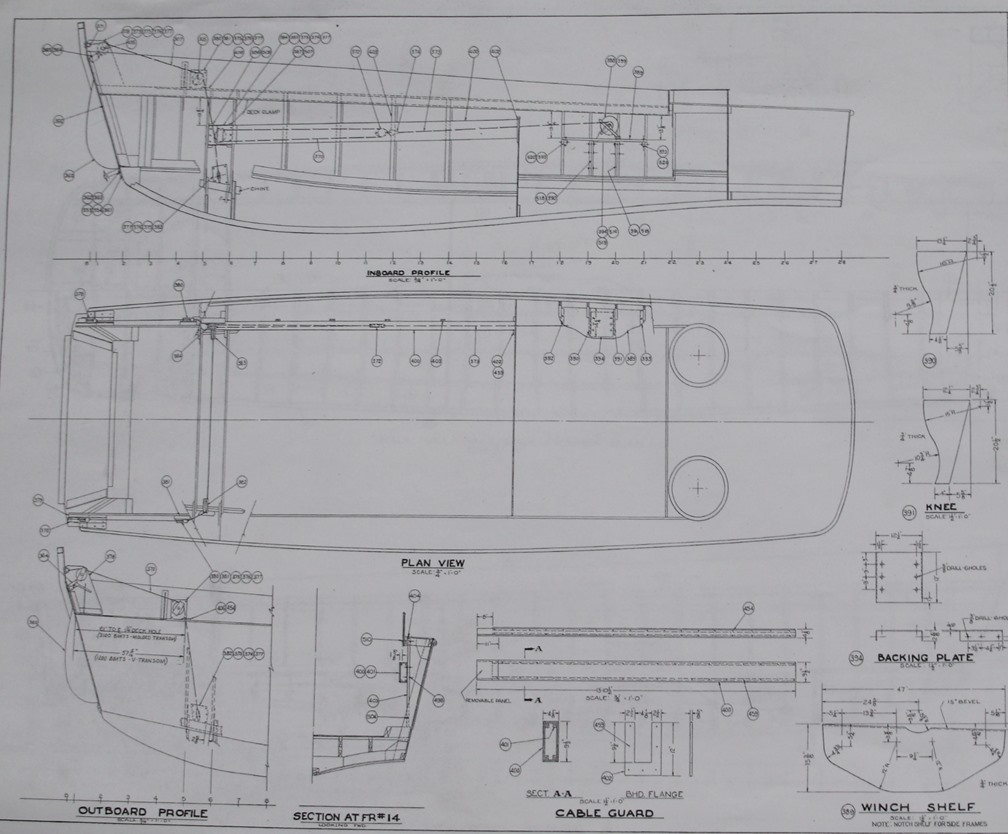
Engineering drawing courtesy of C. Robert
Gillmor added 1-9-2020.

This photo of an LCV shows the winch
located on the rear starboard side gunwale. The cables then run as
shown in the drawing above. The port side cable can be seen
running out from under the deck as shown in the drawing above.

This shows the ramp winch relocated to the
floor of this LCVP. Author's photo.
Registry Plate for LCVP C-40302:
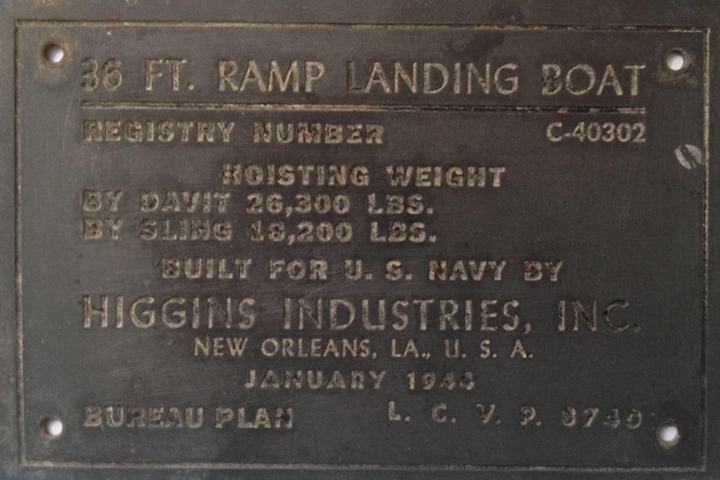
This item is part of the collection of Mr.
John Posusta and tells us that LCVP C-40302 was built in January 1944.
Image courtesy of Mr. John Posusta added 6-15-2024.
Landing Craft, Mechanized (LCM) - On
December 8, 1941 Andrew Higgins applied for a patent for a "Lighter for
Mechanized Equipment." US Patent Number 2,341,866 was granted on February 15, 1944. This became the Landing Craft, Mechanized
in the US Navy nomenclature. It was more commonly known as a Tank
Lighter to the sailors and coastguardsmen who operated it. This term
became the generic term for this type landing craft. Both the
LCM(3) and LCM(6) could deliver one Sherman medium tank directly to the
landing beaches. While the LCVP has gained all of the publicity since World War Two, the LCM
series of tank lighters were just as important and have been
overlooked. Being able to land a Sherman tank on hostile beaches
to provide heavy fire support for the infantry could
make the difference in how quickly the invasion beach could be secured.
Like the Higgins's designed LCVP, the LCM
series was a robust design that continued to be built after World War
Two. Between 1950 and 1987, 1,164 LCMs were built. Ten were
still in service in 2018. This is a strong testament to the
soundness of the original design in Andrew Higgins's patent issued February
15, 1944.
Patent Number
2,341,866 This is the Higgins patent for a ramped LCM.
PT Boats: The 137 PT boats
delivered to the U.S. Navy served in the Aleutians, the Mediterranean,
Normandy, the Southwest Pacific, South Pacific and Central Pacific.
Higgins-built PT boats PT-450 through PT-461 served along the English Channel
from June 1944 to July 1945.
PT-305 - PT-305 had its keel laid down
on March 30, 1943, was launched on May 27, 1943, and was completed
December 8, 1943. On December 22, 1943 it was assigned to Motor
Torpedo Boat Squadron 22, and was based at Bastia, Corsica in the
Mediterranean Theater of Operations. After the invasion of
southern France in August 1944, PT-305 moved to St. Tropez, France.
During her time in the Mediterranean, she was credited with sinking five
enemy vessels. When the war ended in Europe, PT-305 returned to the
United States for deployment in the Pacific. When the war with
Japan ended, she was in New York. PT-305 was struck from the Naval
Register on November 25, 1945. On June 18, 1948, PT-305 was transferred
to the War Assets Administration and was sold in 1948 to the first of
twelve private owners through 2001. During that time period, the
former PT-305 operated as a tour boat and a fishing vessel.
Currently, after 17,000 hours of work by
volunteers at the National World War Two Museum in New Orleans, PT-305
has been restored to her original World War Two configuration. She is the
world's only Higgins-built PT boat combat veteran in operating condition.

PT-305 is in her boathouse at Lake Pontchartrain on the morning of
3-17-2018. She carries the name USS Sudden Jerk. During
World War Two, she also was named Higgins Mortuary, Half Hitch, and Bar
Fly. Author's Photo.
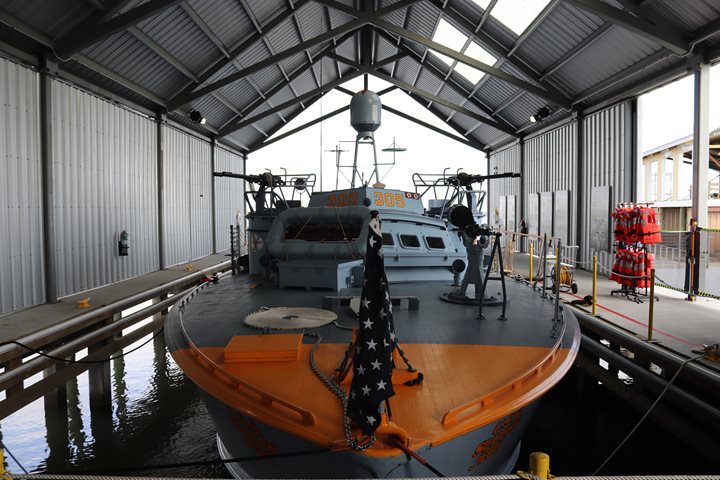
Author's Photo.

Author's Photo.
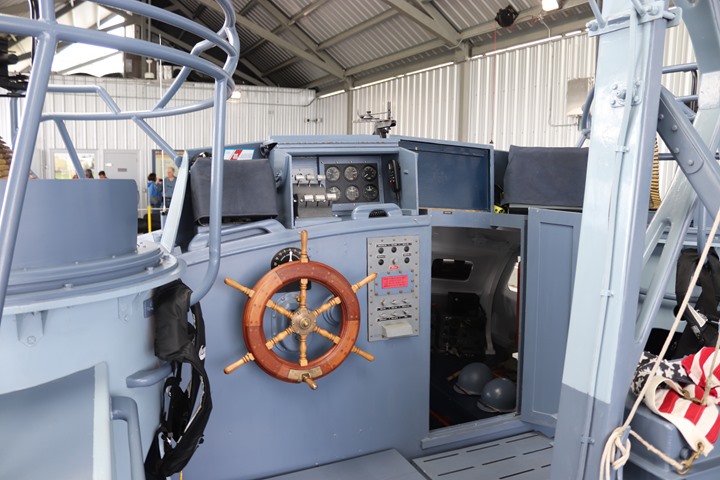
The door to the right leads down into the
chart house and radio room. Author's Photo.
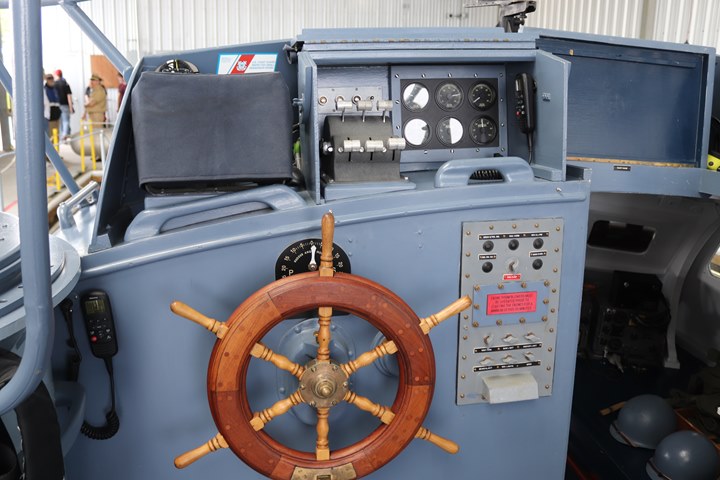
Author's Photo.

Author's Photo.
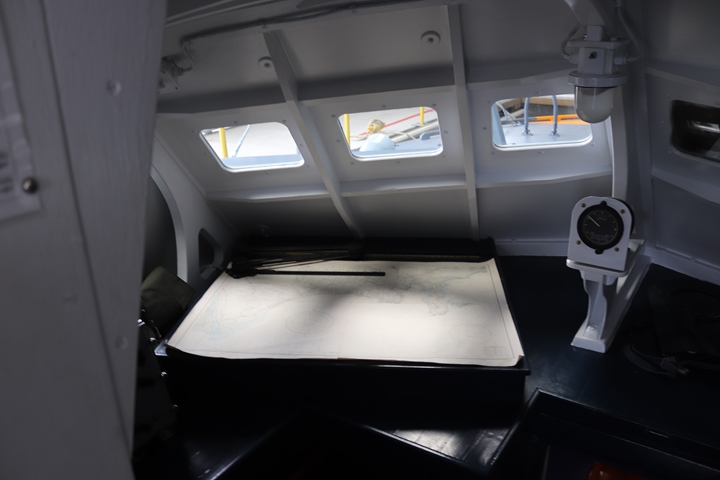
The chart house is on the port side of the
compartment. Author's Photo.
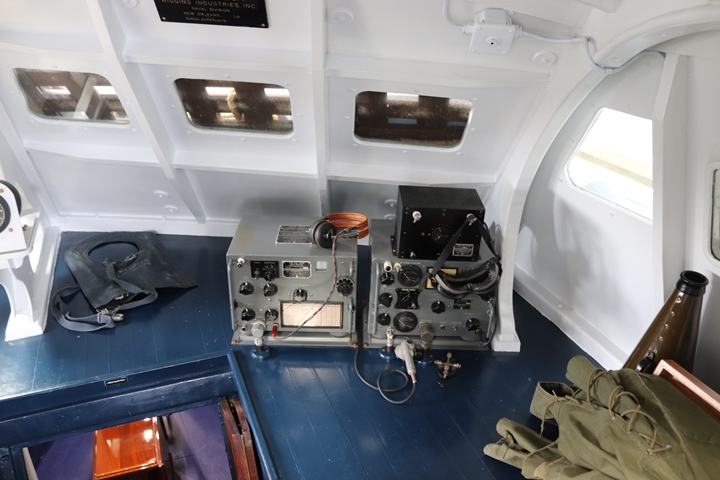
The radio room is on the starboard side of
the compartment. Author's Photo.
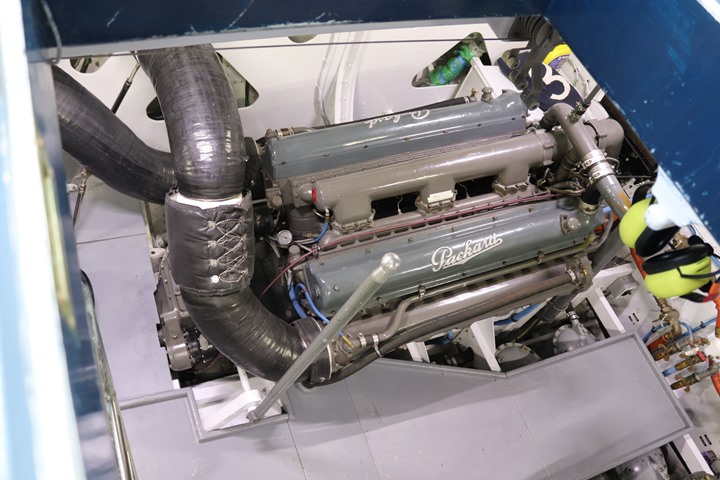
The American Automobile Industry connection
to PT-305 was her three Packard-built 4M2500 marine engines. This is the
port engine. Author's Photo.
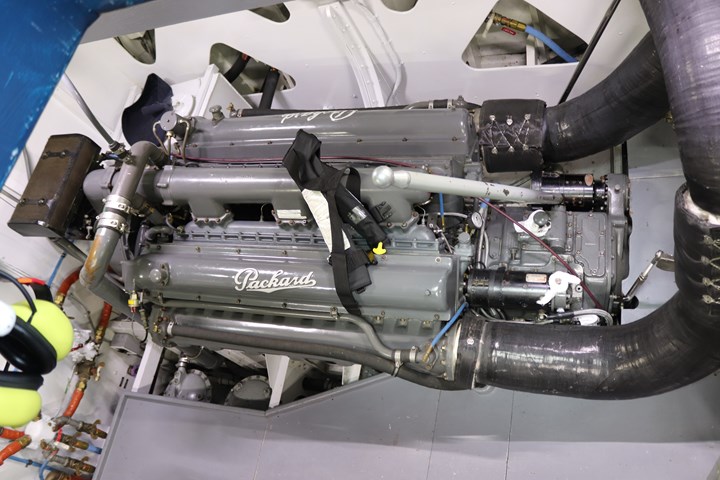
This is the starboard engine with Delco-Remy
Division of General Motors starter and DC generator visible at the rear
of the engine. The Harrison Division of General Motors furnished
the heat exchangers for the engines. Author's Photo.
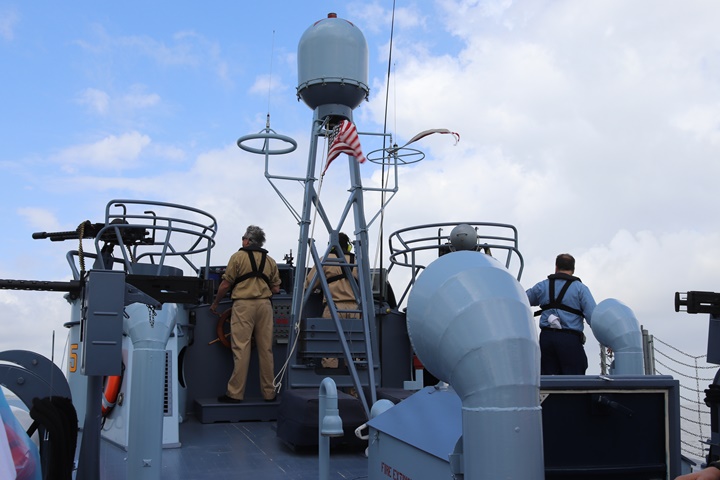
Cruising at 30 knots, the sweet spot for a
Higgins-built PT boat. The flag, the pennants, and the crew member's
pants were whipping around in the wind. This was a nice 70-degree
day on Lake Pontchartrain, so the 30-knot wind over the deck was not too
uncomfortable. Higgins PT boats were used extensively in the
Mediterranean and Aleutians Theaters of Operation during WWII.
Imagine being on deck of a PT boat going 30 knots in the Aleutian
winters. The crewmen suffered many hardships in these small boats.
Author's photo.
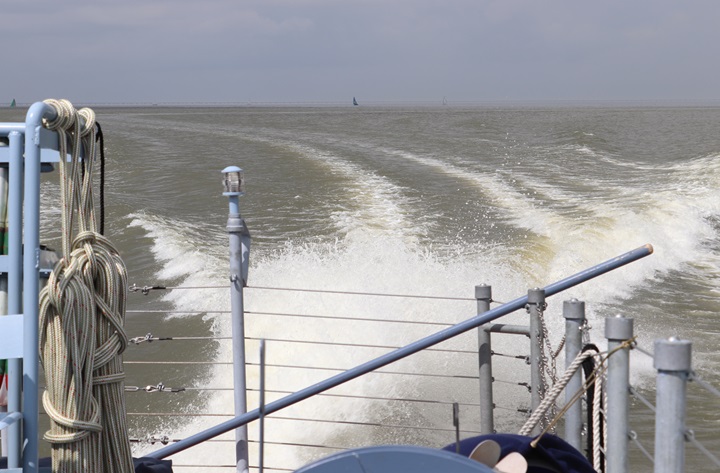
The wake of PT-305 at 30 knots.
Author's photo.
PT-796- PT-796 had its keel laid down
on May 3, 1945, was launched on June 23, 1943, and was commissioned on
July 17, 1945. It was decommissioned on July 7, 1970 and is now on
display at Battleship Cove in Fall River, MA. It is owned by PT
Boats, Inc.
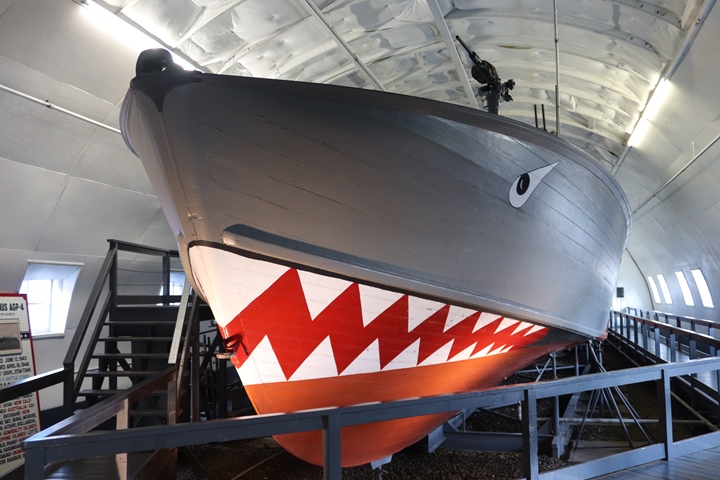
Author's photo added 2-15-2020.
PT-625 Series PT Boat Engineering Drawings:

Two major changes are the replacement of the
bow 37mm cannon with a 20mm Oerlikon and the replacement of the aft
torpedo tubes with depth charge racks. Image added
5-10-2024.

Image added 5-10-2024.

Image added 5-10-2024.
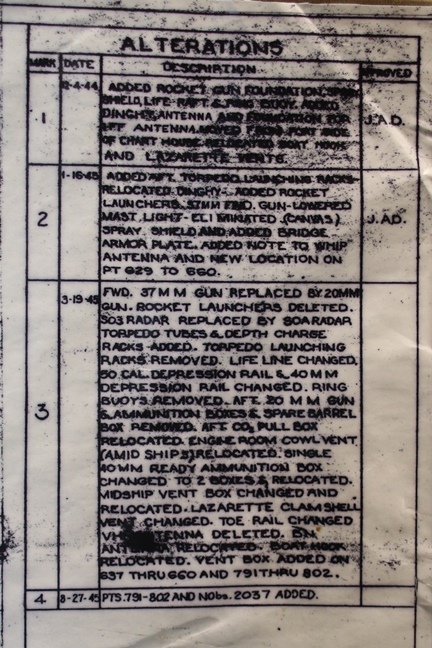
This image shows all of the changes that
went into the last two contracts of Higgins-built PT boats.
Image added 5-10-2024.
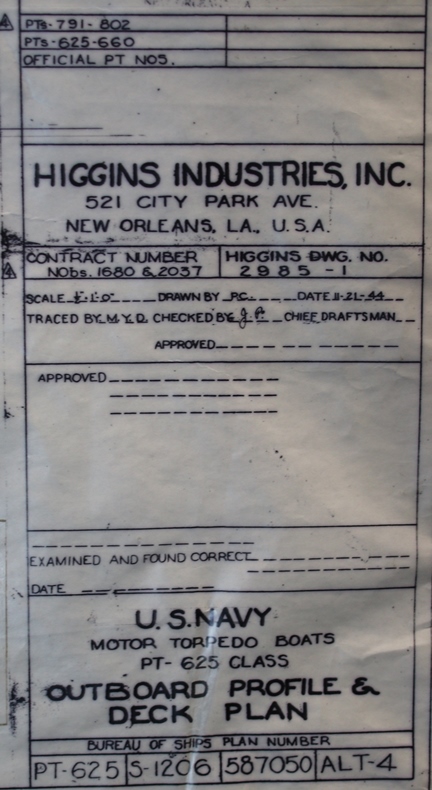
Image added 5-10-2024.
Table 9 - Higgins Industries'
Major World War Two PT Boat Contracts
The information below
comes from the "Alphabetical Listing of Major War Supply
Contracts, June 1940 through September 1945." This was
published by the Civilian Production Administration,
Industrial Statistics Division, Requirements and Progress
Branch January 21, 1946. Table added 5-10-2024. |
|
Product-Customer |
Contract Number |
Contract Amount |
Contract Awarded
|
Completion
Date |
| Motor Torpedo
Boats - Navy |
Nos - 94729 |
$15,941,000 |
11-1941 |
9-1943 |
| Motor Torpedo
Boats - Navy |
Obs -1053 |
$4,714,000 |
4-1943 |
8-1944 |
| Motor Torpedo
Boats - Navy |
Obs -1284 |
$100,000 |
8-1943 |
7-1944 |
| Torpedo Boats PT
- Navy |
Obs -1680 |
$4,899,000 |
5-1944 |
8-1945 |
| Torpedo Boats PT
- Navy |
Obs -2037 |
$1,623,000 |
1-1945 |
11-1945 |
| Total |
|
$27,277,000 |
|
|
From the information above we have cost and
the number of PT boats ordered under contracts Obs-1680 and Obs-2037.
The cost of PT 625-660 built under contract
Obs-1680 was $136,083. This was 36 boats.
The cost of PT 791-802 built under contract
Obs-2037 was $135,250. This was 12 boats.
The information above indicates the average
cost of a Higgins-built PT boat during World War Two was at least
$135,000.
Manufacturing Plants:
Higgins
conducted its boat manufacturing in five different plants during World
War Two. Four were in New Orleans and one was in Houma, LA.
The four plants in New Orleans were the St. Charles Avenue Plant, City Park Plant, the Industrial
Canal Plant and the Michoud Plant. The five of them covered 1,486
acres and employed 20,000 workers. When the boats were completed
at the St. Charles Avenue Plant or the City Park Plant, they were
transported by truck or rail to St. John Bayou, a small river on the
north side of New Orleans. The St. John Bayou was one mile east of
the City Park Plant by road. The boats were then taken out on Lake
Pontchartrain for testing. When the testing was complete, the
boats were loaded onto railway cars to be shipped to their final
destination. The boats built at the Industrial Canal Plant would
be launched on the Industrial Canal, tested, and then delivered to the
St. John Bayou for shipment.
St. Charles Avenue Plant:
This was Higgins Industries' original plant
It built the early landing craft and PT boats. All of
the boats were trucked to the Bayou St. John for testing and delivery.
On May 30, 1941 the USMC ordered 50 LCMS from Higgins Industries.
Ten had to be delivered to Norfolk, VA by June 30, 1941. The first
ten LCMS were built at the St. Charles Ave. plant. Due to the size and time
frame of the project, some of the work was done outside on Polymnia
Street at the end of the block northeast of the plant. Tarps were
placed over the buildings on either side of the street to
protect the workers from the elements. Vehicles were not able to
use the street during the work, which was an inconvenience for the
residents. They accepted the inconvenience as necessary to get the boats built. Final
assembly was done in a nearby vacant stable.
St. Charles Avenue was closed as a
production facility in March 1942. LCM work shifted to the City
Park
Plant temporarily until the Industrial Canal Plant opened. Higgins headquarters moved from St. Charles Avenue to the City
Park Plant in September 1942.
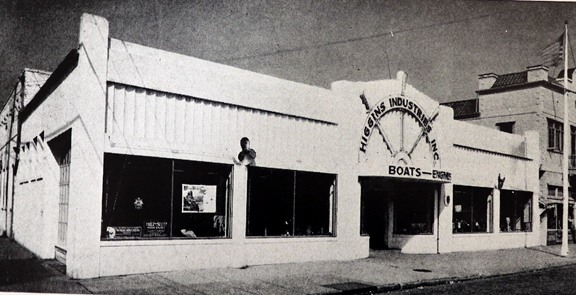
The Plant was located at 1755 St. Charles
Avenue in New Orleans. Today Houston's Restaurant is at this location. It does not appear to be the same building as this one. Apparently
this one was torn down, and a new one built in its place.
City Park, New Orleans,
LA Plant: Higgins purchased the former Albert Weiblen Marble
and Granite Works plant at 521 City Park Avenue in July 1940, and converted it to the world's
largest boat manufacturing plant under one roof. The construction
of the PT boats and landing craft was done on the second floor, with the
completed boats lowered to ground level by an elevator. Because
the plant was not near water, the boats were then moved by rail or truck
to Bayou St. John for testing and shipment. Today the plant is the
location of Delgado Community College Administration building and
adjacent parking lot. Only a historical marker at
the college indicates that this was once the location of a thriving
plant that built thousands of boats for the winning of World War Two.
Higgins implemented assembly line techniques developed by
the American Auto Industry, allowing the facility to turn out thousands
of landing craft and 216 PT boats.
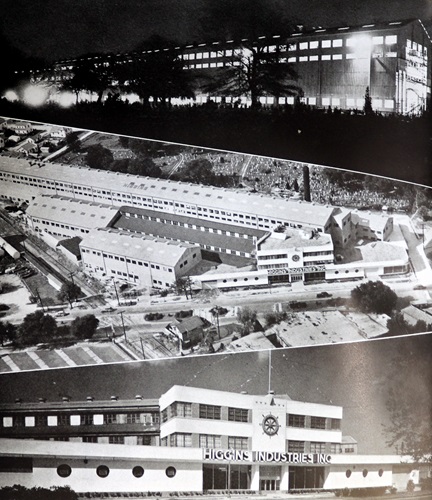
The top photo is City Park Plant at night. Apparently, there
was no black-out in New Orleans. The middle photo looking
northwest, the City Park Plant is bounded by City Park Avenue on the
south side, the railroad tracks on the west side, and the Holt Cemetery
to the north. The bottom photo shows the main entrance to the
plant along City Park Avenue.
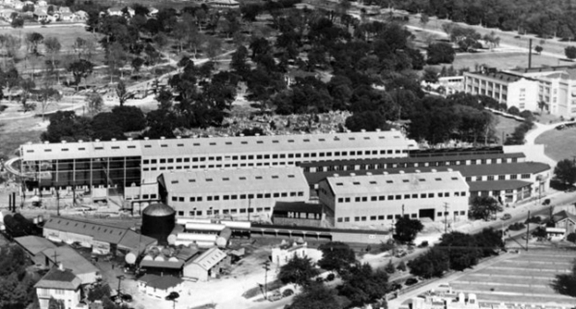
This view of City Park Plant is looking
north to northeast, while the Isaac Delgado Hall of the Delgado Community
College is to the northeast of the plant.
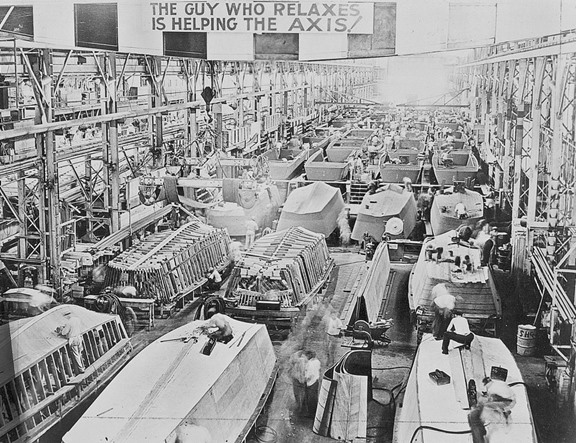
The final assembly line on the second floor
of the City Street Plant building LCVP landing craft. Assembly of
PT boats took place in the next bay.
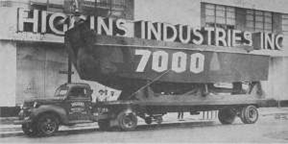
The 7,000th LCVP built by Higgins in October
1944 is in front of the City Park Plant for a photo shoot. From
here, the LCVP went to Bayou St. John for testing and final delivery to
the U.S. Navy.
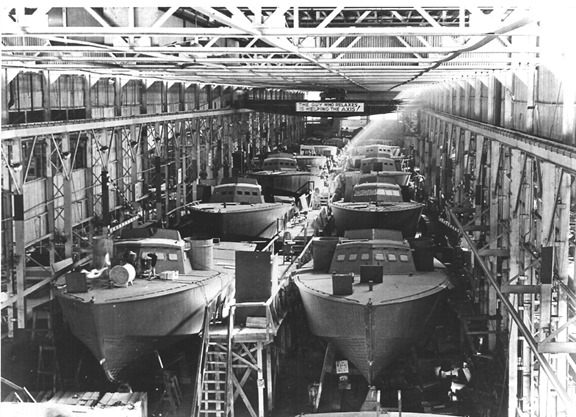
The PT boat assembly line at the City Park
plant. Note the overhead crane that runs the length of the
building to deliver large components to the assembly area.
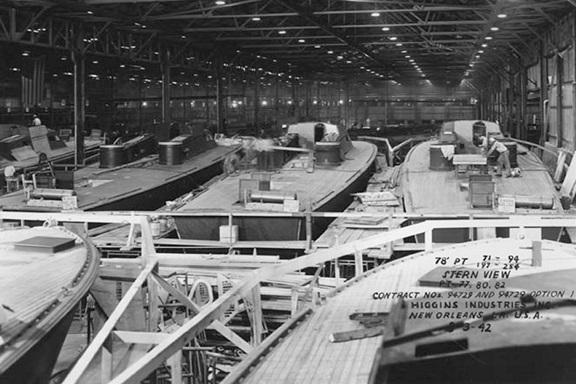
PT-77, PT-80 and PT-82 are shown in this
stern view from 8-3-1942. This photo is significant in that it
shows the PT boats being built at least four abreast. Photo added
3-4-2019.
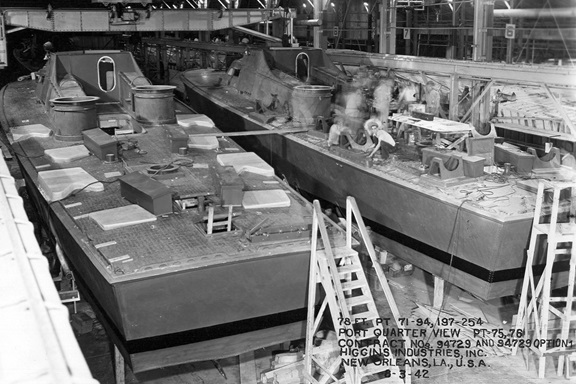
The stern view of PT-75 and PT-76 are seen
in this photo from 8-3-1942. Photo added 3-4-2019.
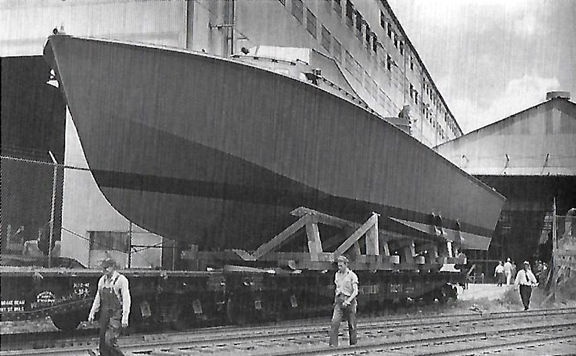
A PT boat exits Park City via railroad
transport to nearby Bayou St. Johns northeast of the plant.
Industrial Canal, New Orleans,
LA Plant: Land was purchased along the Industrial Canal for
a new plant. While Higgins and his staff drove to the negotiations for the purchase of the land for the plant, they were
listening to the car radio broadcast of news of the attack on Pearl
Harbor. The land was purchased, and workers started clearing the
land for construction the same day. Construction began on
the plant in January 1942 and it was dedicated on September 13, 1942.
First construction was for 150 50-foot LCM Tank Lighters that the British
had ordered in late 1941. The plant built at least 1,400 LCMs by the end of the war, most of them for the U.S. Navy. The
plant also built the 100 170-foot FS ships for the US Army.
Higgins built torpedo tubes at the plant that were activated by compressed air for
its PT boats. This product did not last to the end of the war
because the U.S. Navy went to a simpler roll-off torpedo launcher.
The plant also built the J-boats, tugs barges and other small boats for
the U.S. Army and Coast Guard. It was a busy place during World
War Two.
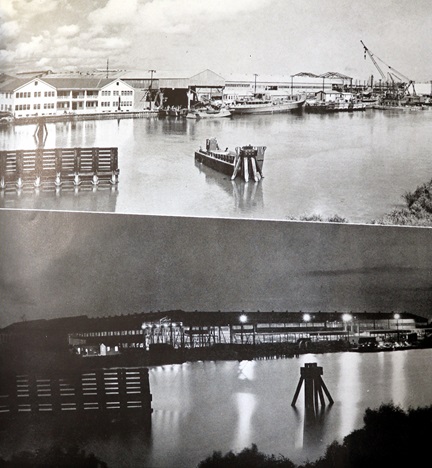
Two views of the Industrial Canal plant from
World War Two.

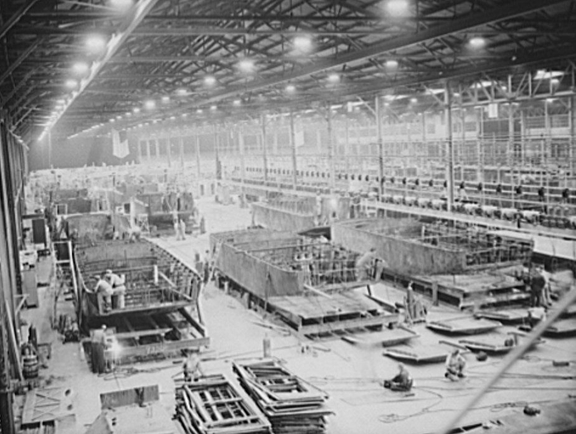
Inside the long assembly bay of the
Industrial Canal Plant, six LCM Tank Lighters are under construction in
the foreground with many others towards the rear of the plant. The
LCM(6) was fifty feet long and fourteen feet across the beam. In
October 1944, the Industrial Canal Plant produced its 1,000th LCM, having
started in September 1942 with a run rate of 450-500 per year. By
the end of the war, Higgins produced at least 1,400 of the LCMs for both
the U.S. Navy, the U.S. Army and the British. The British ordered 150 of the 50-foot tank lighters in early 1942. Production of the LCM commenced
in early June 1941 at City Park Plant. It then moved to Industrial Canal when
it opened.
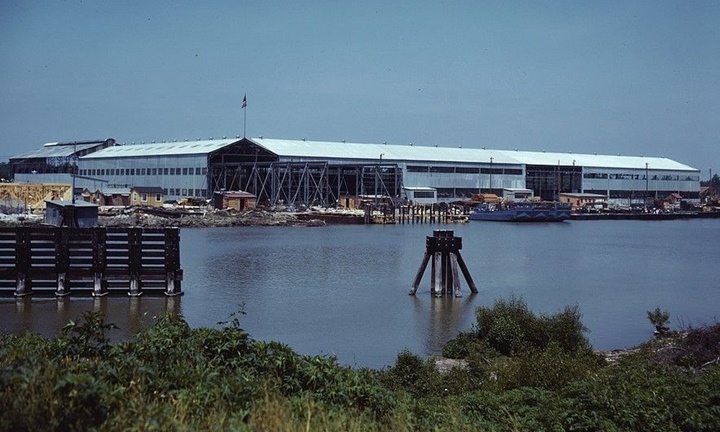
A contemporary view of the former Higgins
Industrial Canal Plant. This was the primary ship and boat building
plant for Higgins Incorporated after World War Two. However, the
plant was too big to compete with the smaller boat manufacturers, and
too small to compete with the larger ship manufacturers. In the
end this led to the final demise of the Higgins' operations in 1959.
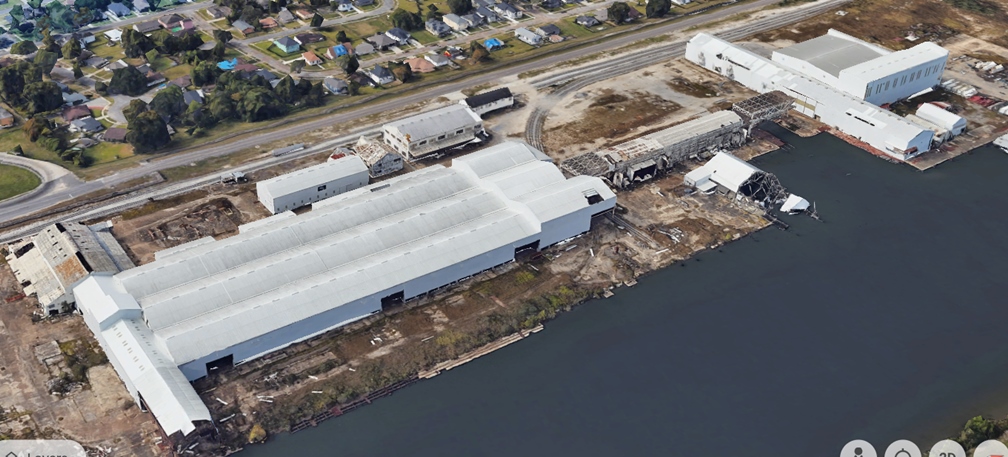
This Google Earth image shows the current
state of the former Higgins Industrial Canal plant complex. While
the factory buildings seem to be in relatively good shape, the covered
monorail structure is in poor condition. It was the monorail that
carried the completed LCMs from the building on the left out out the the
canal for launching. Image added 5-10-2024.
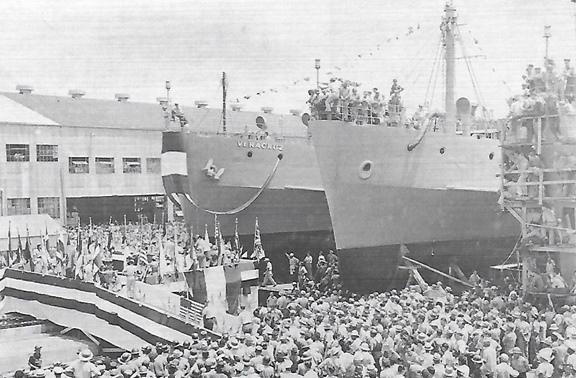
FS ship the Veracruz is launched at the
Industrial Canal Plant. Industrial Canal had the only moving
assembly line for cargo ships in the country.
Bayou St. Johns, New Orleans, LA: This
is where all of the boats came for testing and final shipping.
Sometimes the boats would be finished without engines and stored here
until they could be installed. The PT boats after initial work was
completed at the City Park plant were delivered to Bayou St. Johns by
railcar. Here they would be finished out, which took normally about
five months of work.
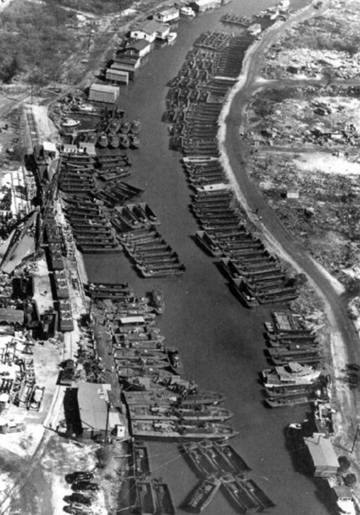
There are around 135 boats in this photo,
most of them landing craft. The majority of the landing craft
appear to be the fifty-foot LCM Tank Lighter. Near the bottom of
the left side of the photo are three 78-foot PT boats. Just above
them are about twelve smaller boats which are the 36-foot LCS(S) boats.
There are another seven LCS(S)s near the top of the photo.
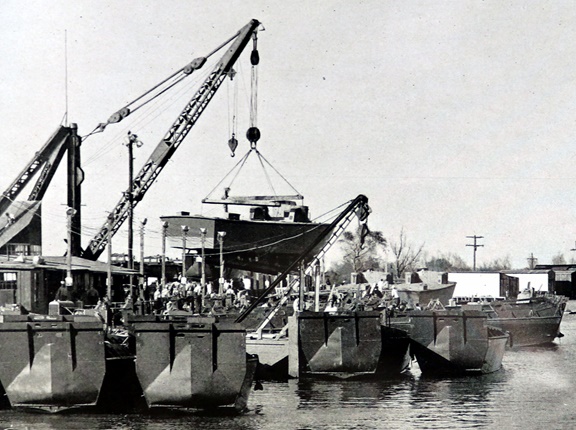
An unfinished PT boat from the City Park
plant is lowered into the water for the average five-month finishing out
process.
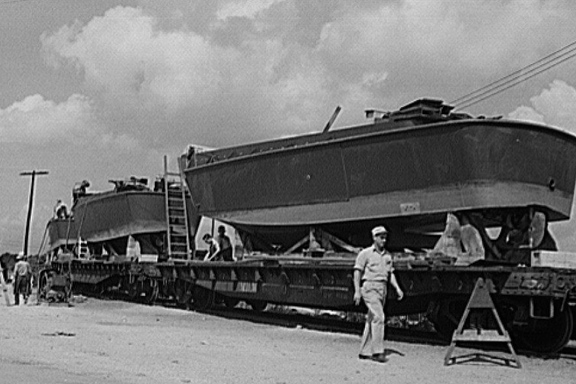
LCVPs are being loaded on to railroad cars
at Bayou St. John for shipment to the U.S. Navy. Note that they
have the rounded chines on the stern.
Higgins Engine Company Plant, New Orleans,
LA: In March 1942, Higgins purchased the Tucker Aviation
Company of Ypsilanti, MI, and formed the Higgins-Tucker Engine Company to
build marine engines for his boats, as there were engine shortages during
the war. The company was renamed Higgins Engine Company after
Preston Tucker, CEO of Higgins-Tucker Engine resigned in December 1943.
The engine shortage went away, and only 100 engines were produced to fulfill a government
contract near the end of World War Two. Afterwards Higgins Engine
was dissolved.
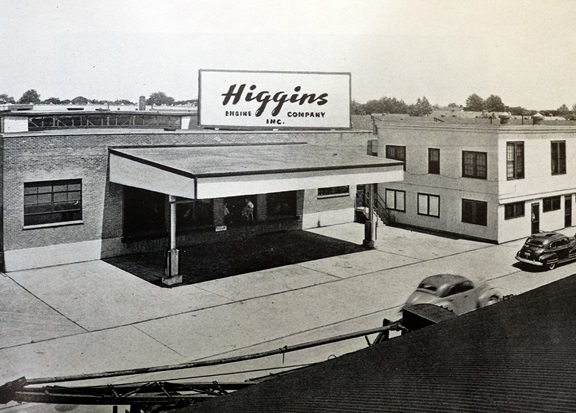
Victory Plant, New Orleans, LA:
During World War Two Higgins Industry cut
LCMs into several pieces with torches. The components were then
boxed at the Victory Plant where they could be more easily shipped in
the hold of a transport. U.S. Army engineers near the war fronts then re-welded the
parts back into the final LCM. This process was an Andrew Higgins
invention.
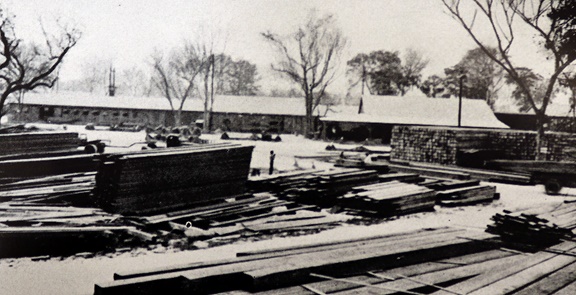
West End Plant, New Orleans, LA:
This was located on the New Basin
Canal. Military boat operator and maintenance
training was conducted in this plant for a good portion of the war.
The training moved to another location when the numbers of trainees
exceeded the capacity of the building. By the end of the war
300,000 military personnel were trained by Higgins Industries in New
Orleans.
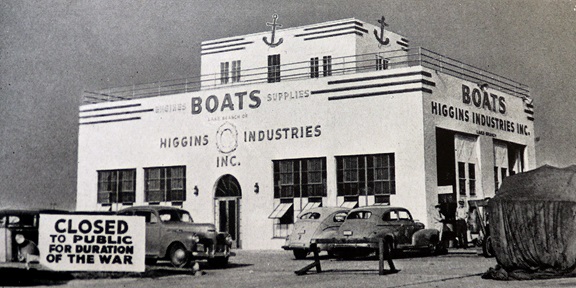
Industries Building,
New Orleans, LA: Occupied
by Higgins in September 1943. The first four floors of this
eight-story building at Gravier and South Saratoga Streets in New
Orleans were the employment offices for Higgins Industries, Higgins
Aircraft, Higgins Engine Company, and Higgins Plastic Corporation.
The fifth and sixth floor were leased out.
Higgins Aircraft Plant, Michoud District,
New Orleans, LA: Construction on this plant
started in April 1942, to build
100-200 Liberty Ships on four parallel production lines. Work stopped on July 18, 1942, when the Liberty Ship
contract was cancelled for lack of steel. Work resumed on the
plant to convert it from a ship building facility to an aircraft plant.
This transpired when Higgins received a contract to build 1,200 Curtiss
C-76 all wooden twin engine transport aircraft. This contract was
then cancelled on August 3, 1943. The same day it was
announced that Higgins Michoud would build C-46 Commando transport
aircraft. Only one C-46 was produced at Michoud as the contract for C-46s was
also cancelled, as this type
aircraft was no longer needed for the war effort. The Michoud
plant went on to build the A-1 Lifeboats and the carbon parts for the
Manhattan Project.

Michoud was a 2,324,000 square foot complex in
a total of 21 buildings. The main assembly building shown above
was 1365 feet by 1095 feet for 1,494,675 square feet. With the
side building and mezzanine it totaled 1,872,000 square feet in size.
The office building was a two-story structure, 50 feet by 837 feet for
78,000 square feet, while the engineering building was also two stories
at 50 feet by 1,257 feet for 108,000 square feet. In 1946 the
building complex was up for sale by the War Assets Administration.
During the Korean War, the plant was reopened by the government.
Chrysler was given control of the plant to build Continental VA-1790
tank engines under license for M47 tanks. AV-1790 engines came off
the Michoud assembly lines from May 1952 until July 1953 when the plant
was again taken out of service.
In 1962 NASA acquired the facility, and made Saturn 1B and 1C boosters for
the Apollo program. Today it is still part of NASA.
Houma, LA Plant: This is the
least well known and the smallest of the Higgins Plants from World War
Two. It produced landing craft and rocket launching boats LCS(S)
while it employed 170 local Cajuns. Production of both products
would have been minimal compared to the high production plants in New
Orleans, but the plant did provide wartime employment in the area while providing needed
landing craft for the military.
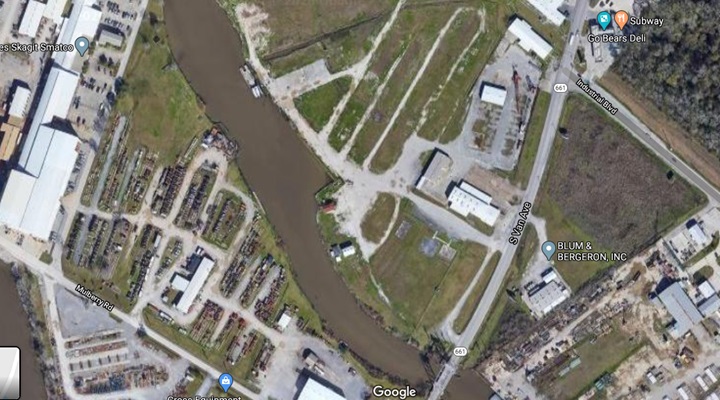
The Higgins Industries Houma Plat has been
described at being at the location of South Van Avenue and Industrial
Boulevard in Houma, LA. This satellite photo shows this location.
There is evidence of something being there in the past. This is
along the Bayou Lacarpe which feeds into the Intercoastal Waterway both
to the north and south of this location. Photo courtesy of Google
Maps added 2-15-2020.
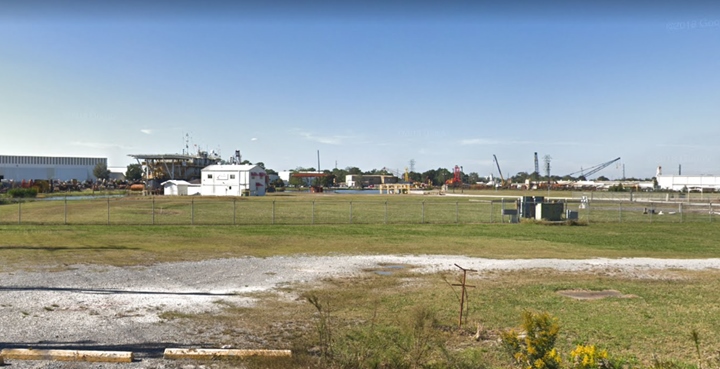
This is a street view from South Van Avenue
looking north. Photo courtesy of Google Maps added 2-15-2020.
Higgins World War Two Magazine
Advertisements:
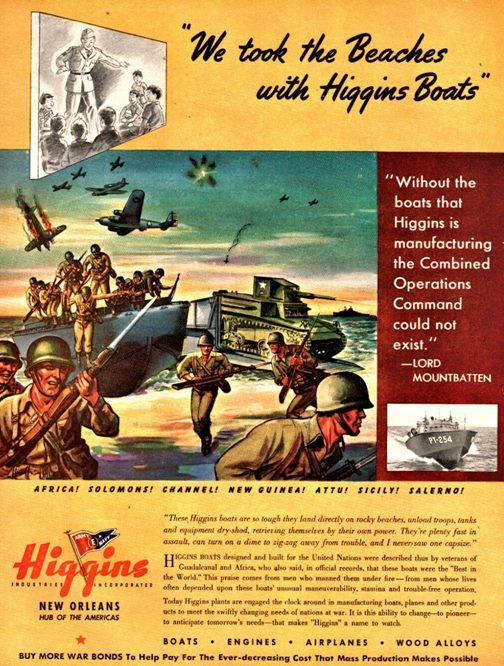
PT-254 was completed on June 16, 1943.
Salerno was invaded in September 1943, making this a late 1943 or early
1944 advertisement.
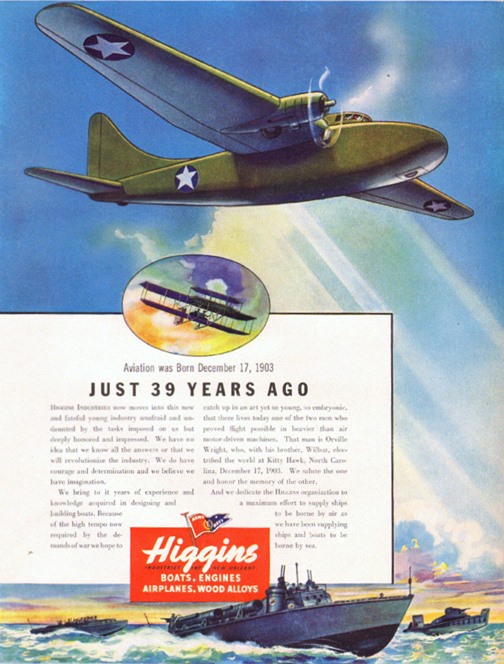
The aircraft in the advertisement is a
Curtiss C-76 Caravan twin engine transport of wooden construction.
Higgins' contract for 1,200 of the C-76s was cancelled in early August
1943.
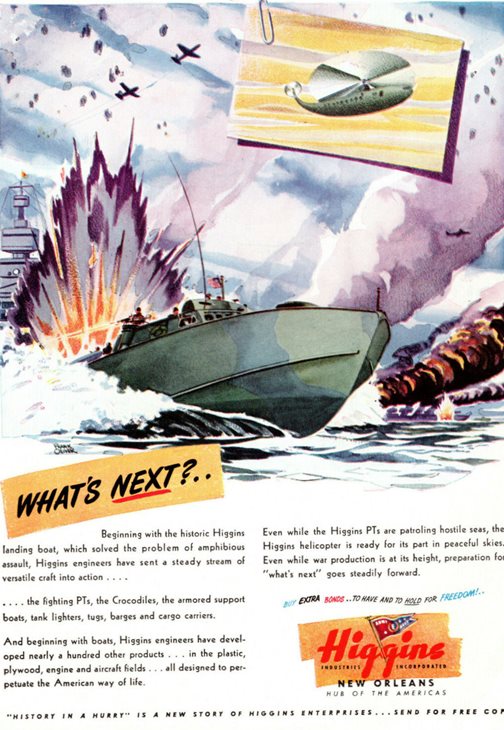
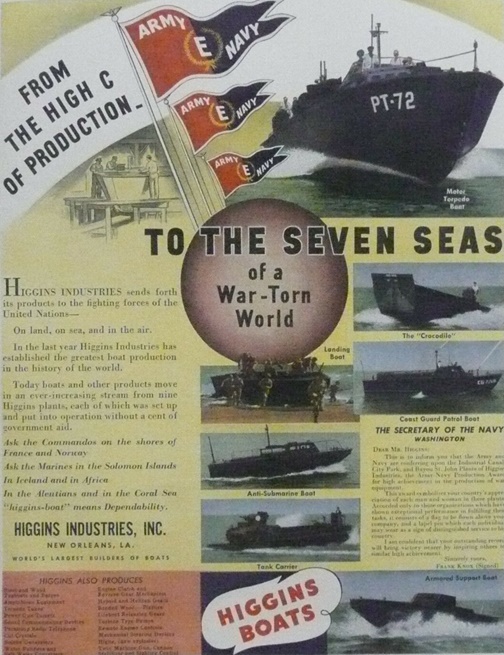
This advertisement gives
some hints as to what the missing boats may be from the total of Table 5 above.
-
The "Crocodile" is an LCV. Higgins built around
1,200 of these. I have never seen it referred to as the
"Crocodile."
-
The Coast Guard Patrol
Boat shown is a 38-foot Picket Boat. A number of small boat
builders built 470 Picket Boats in early World War Two. Higgins
portion would probably not have been significant
in the total number of boats it built.
-
The Landing Boat is the
LCP(L), of which Higgins built 1,100.
-
The Anti-Submarine Boat
is an unknown. There are no references to it in the "Higgins
Biography."
-
The Tank Carrier is the
LCM.
-
The Armored Support Boat
is the LCS(S) that the "Higgins Biography" calls either the
rocket boat or LCS. It was built both in Houma and New Orleans.
-
Date of the
advertisements would be after late 1943 based on the three "E"
awards.
Post World War Two: After World War Two,
Higgins Incorporated continued to build boats. During the Korean
Conflict, Higgins operations in New Orleans again produced boats and
ships for the military. Among them were ten 165-foot minesweepers,
21 100-foot tugboats, and 322 90-foot LCM(8)s for the U.S. Navy.
The Army Corps of Engineers ordered 900 27-foot bridge erection boats of
its own design from Higgins. The bridge erection pontoon boat
shown below was formerly at the National Military History Center in
Auburn, IN. The information shown below is all that I could find on this boat. Of the 900 built, this is the only one I
have ever seen, making it a very rare historical artifact.
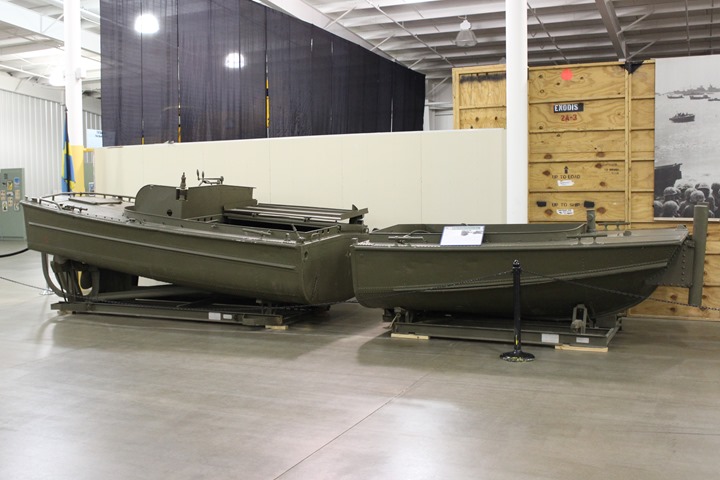
Author's photo.
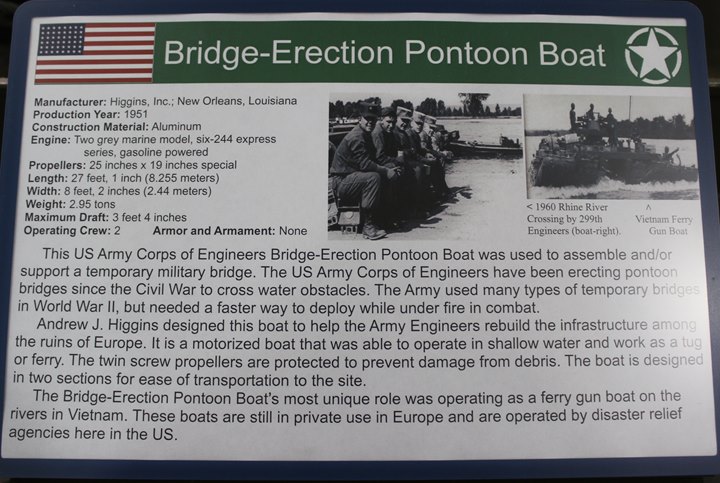
Author's photo.
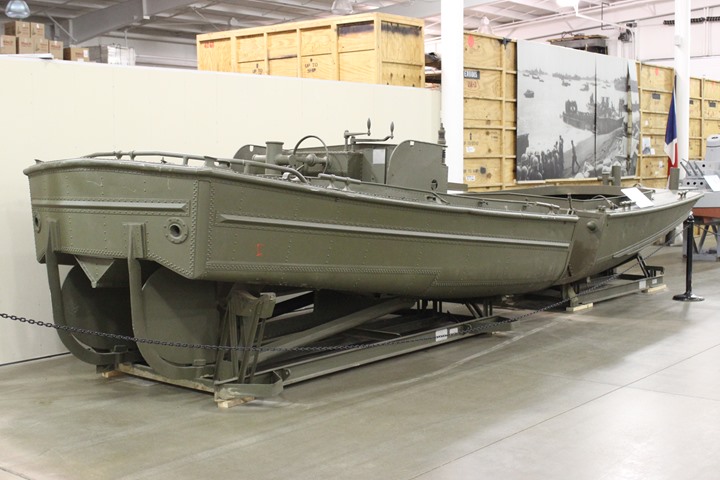
Author's photo.
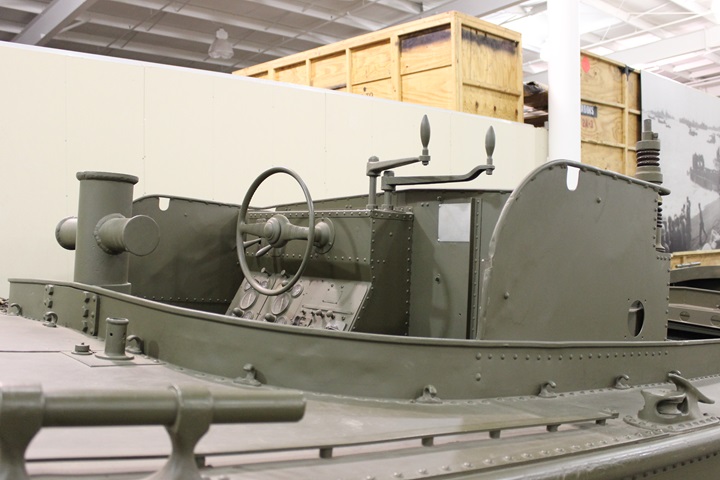
Author's photo.
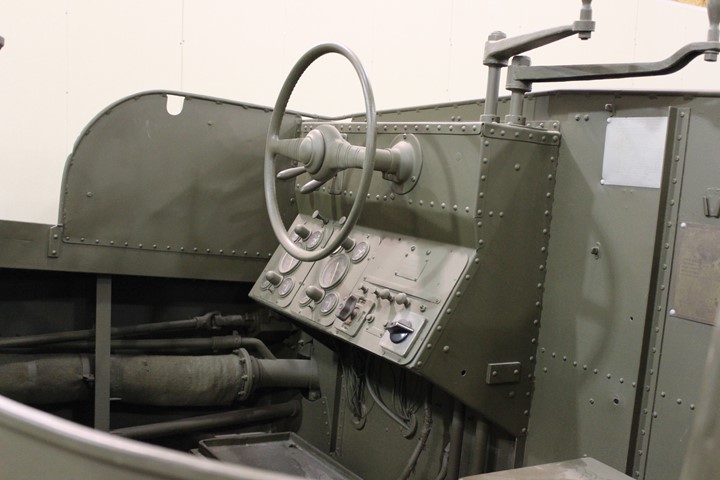
Author's photo.
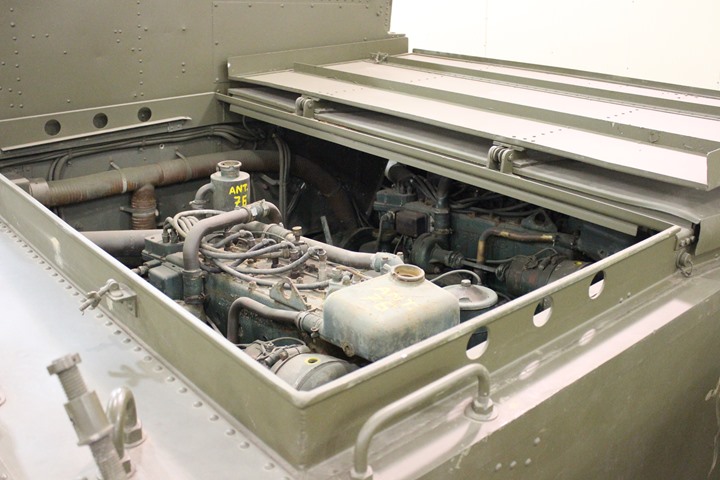
Author's photo.
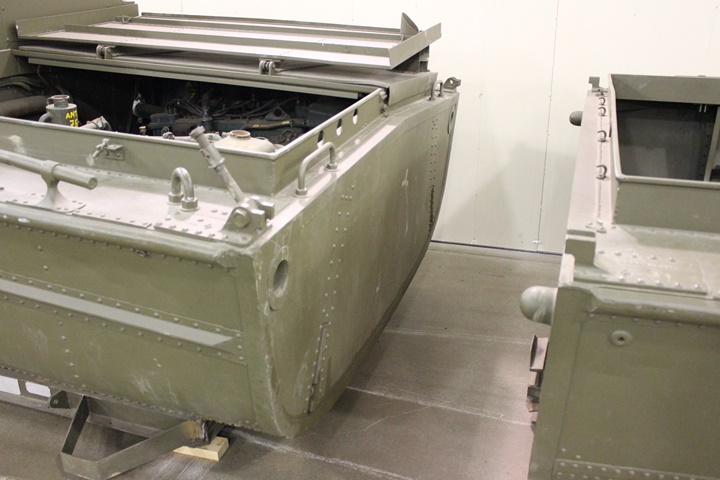
Author's photo.
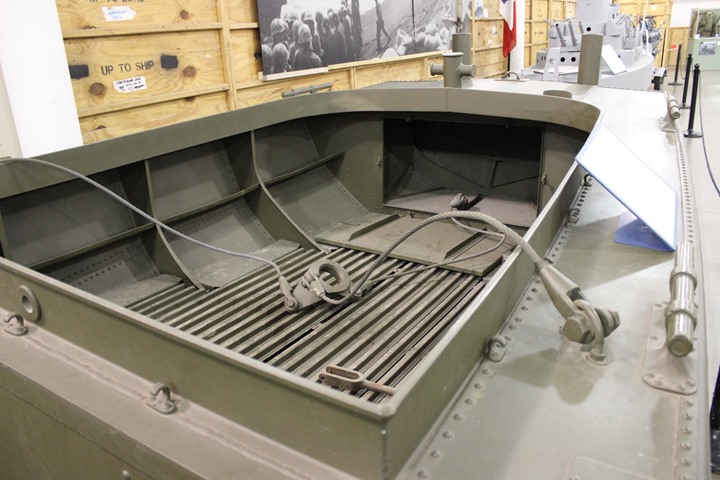
Author's photo.
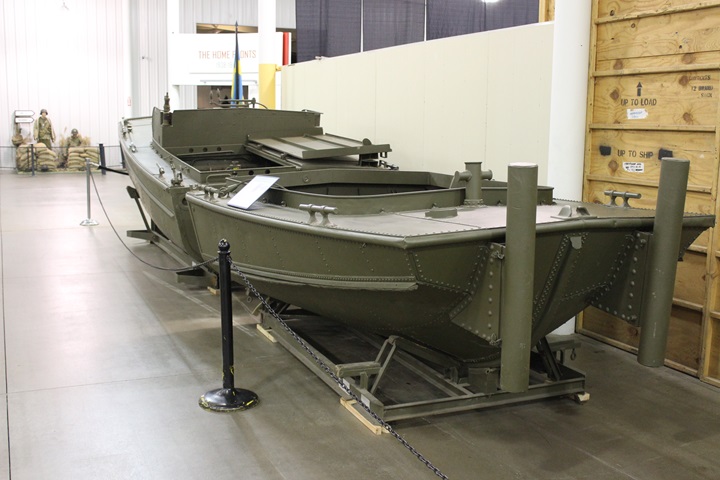
Author's photo.
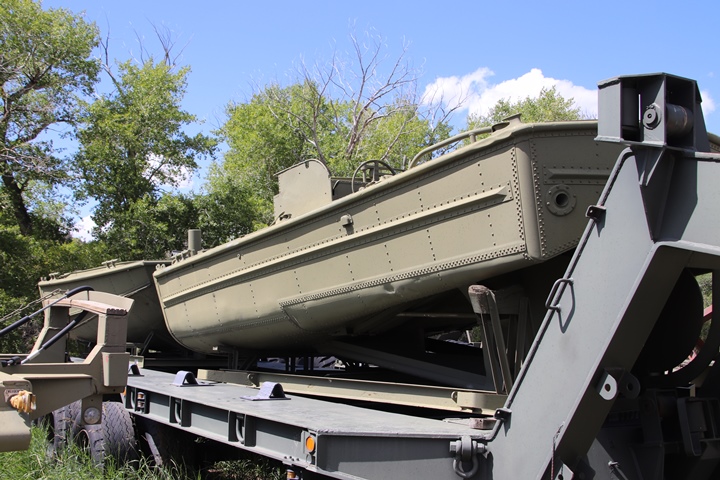
In August 2023, I re-discovered the Higgins
bridge erection pontoon boat at the National Museum of Military
Vehicles. It was on outside display. Author's photo added
5-10-2024.
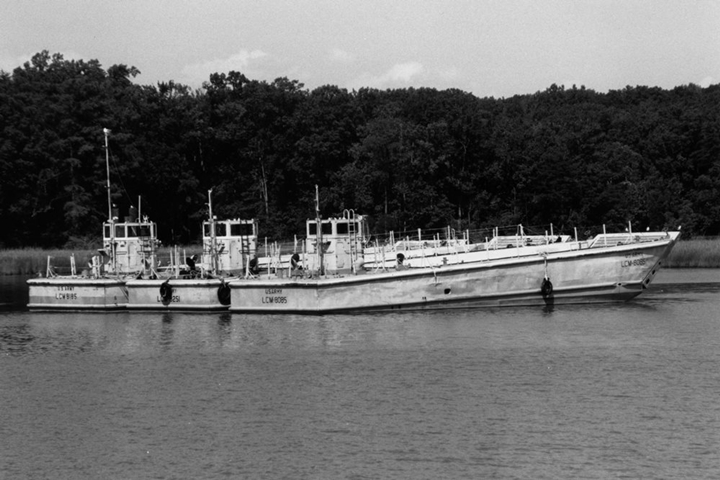
The nearest boat in this photo at Fort
Eustis, VA is LCM8095 which was built by Higgins Incorporated during the
Korean War. The LSM-8s were a compromise design between the U.S.
Navy Bureau of Ships and Higgins Incorporated. The hull design was
that of the Bureau of Ships, and the bow and ramp were that of Higgins.
Higgins began production in the spring of 1953. The Higgins-built
LCM-8s were ordered by the U.S. Navy for the U.S. Army. This
particular series of boats had both Army and Navy numbers associated
with them. The estimated Army numbers are from LCM8001 to ~ LCM8307 and
the Navy estimated numbers from LCM200615 to
~LCM200821. Photo and information courtesy of George Schneider
added 11-24-2022.
|












-83w-1.jpg)
rocket-52w-1.jpg)


















































































































